BOMBE US de 1000 lb AN-M65

American GP AN-M65 bomb weighing 1000 Lbs (454 kg).
The explosive charge represents 50% of the total weight, i.e. around 226 Kgs.
3 types of explosive were used in GP (General Purpose) bombs:
…Trinitrotoluene (TNT).
…Amatol (a military explosive composed of a mixture of TNT and ammonium nitrate).
…Composition B (RDX), which explodes faster and more violently than TNT.
The bomb is detonated by an AN-M103 warhead and an AN-M102A2 tail fuze.
This type of bomb is used on Boeing B-17 or Consolidated B-24 “Liberator” flying fortress bombers.
It can also be fitted ventrally to Republic P-47 Thunderbolts.
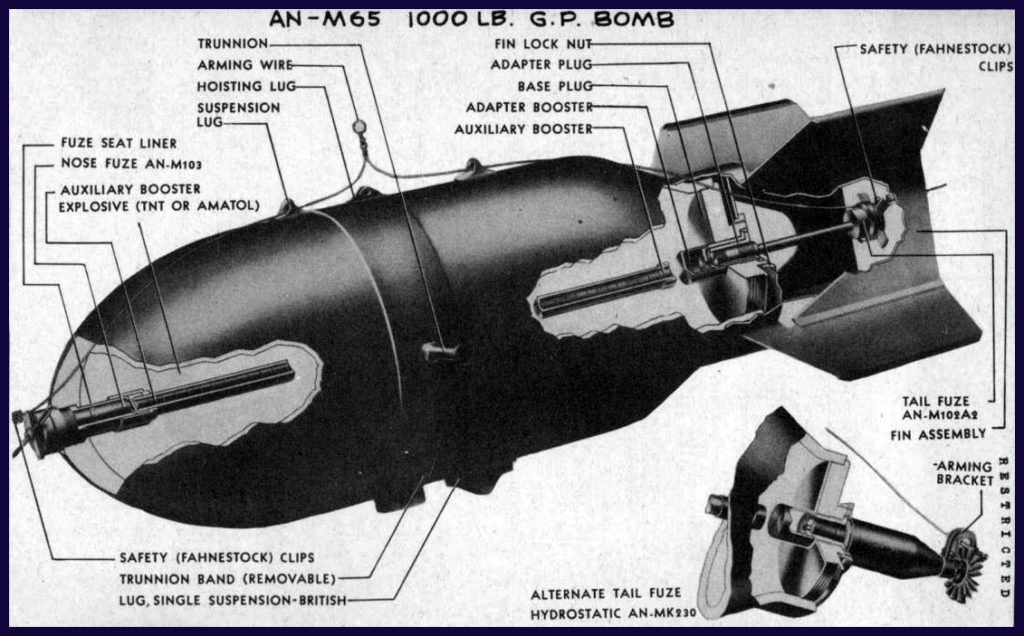
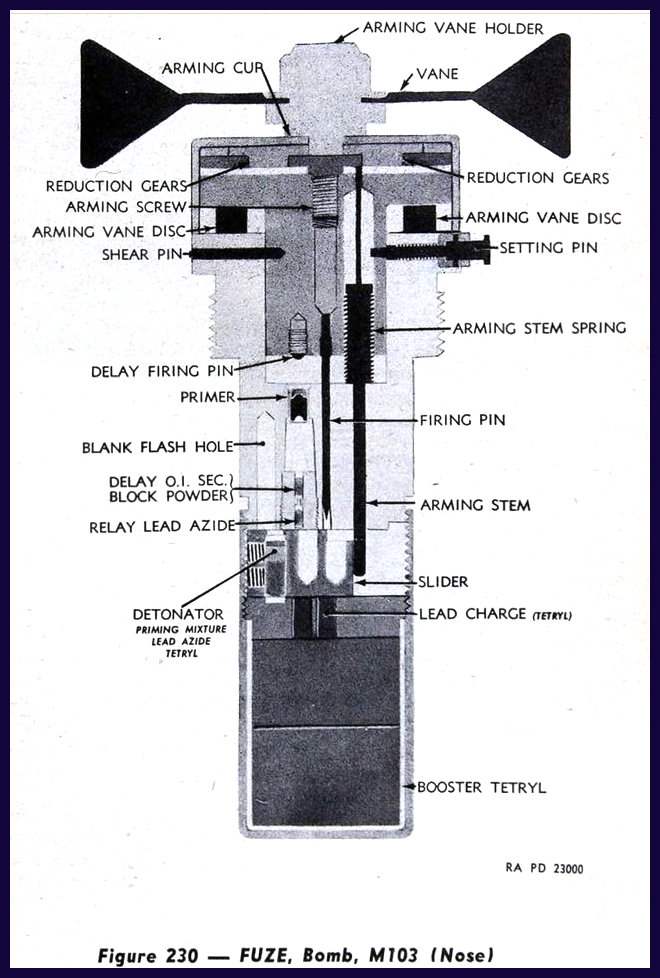
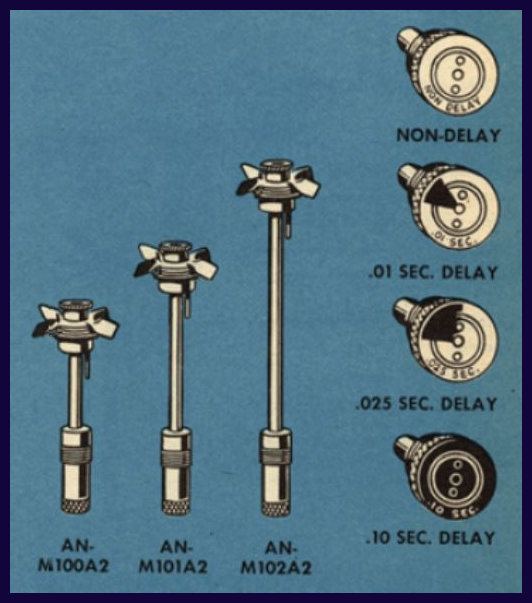
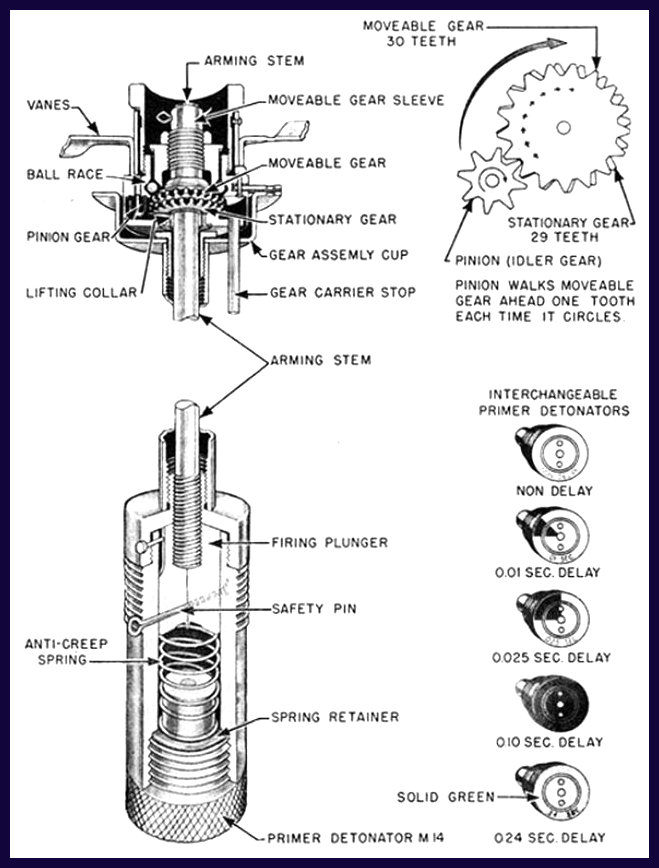
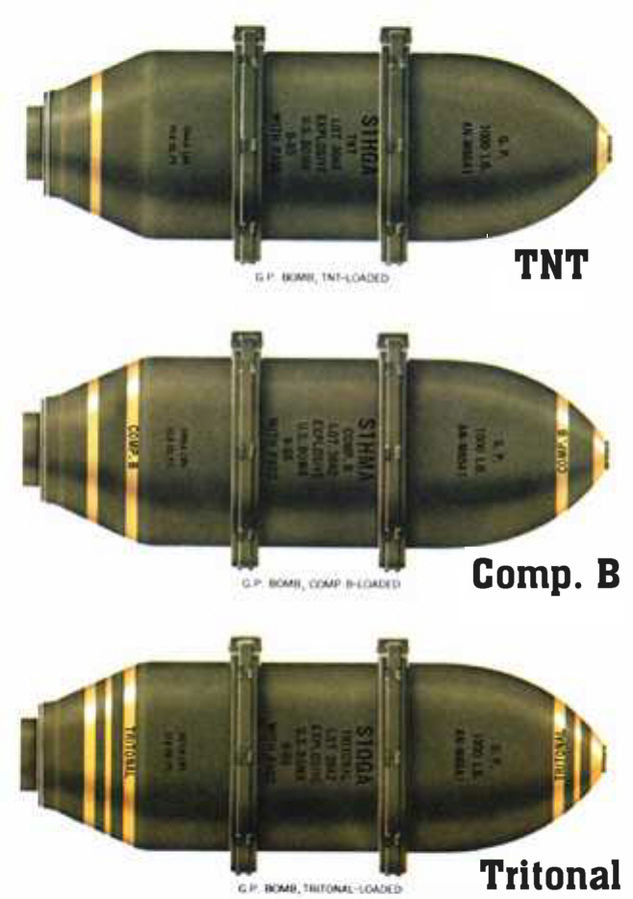
BOMBE US 260 lb Frag AN-M81
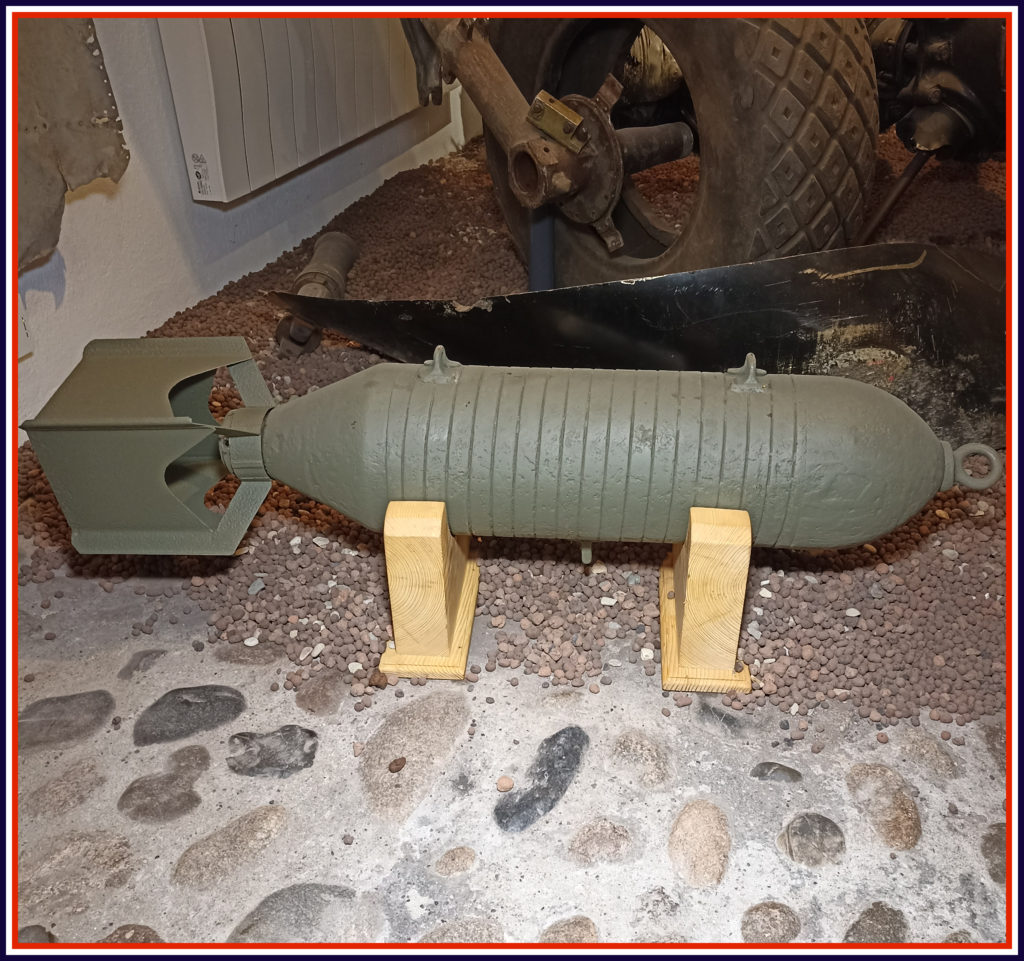
American AN-M81 fragmentation bomb weighing 260 Lbs (117 kg) against personnel and unarmored vehicles.
The explosive charge represents 15% of the total weight (18 Kgs).
The bomb is primed by a fuse with an AN-M103 warhead and AN-M100A2 base.
On detonation, the metal coil enveloping the entire bomb is transformed into hundreds of dreaded metal fragments, causing enormous damage to people and equipment.

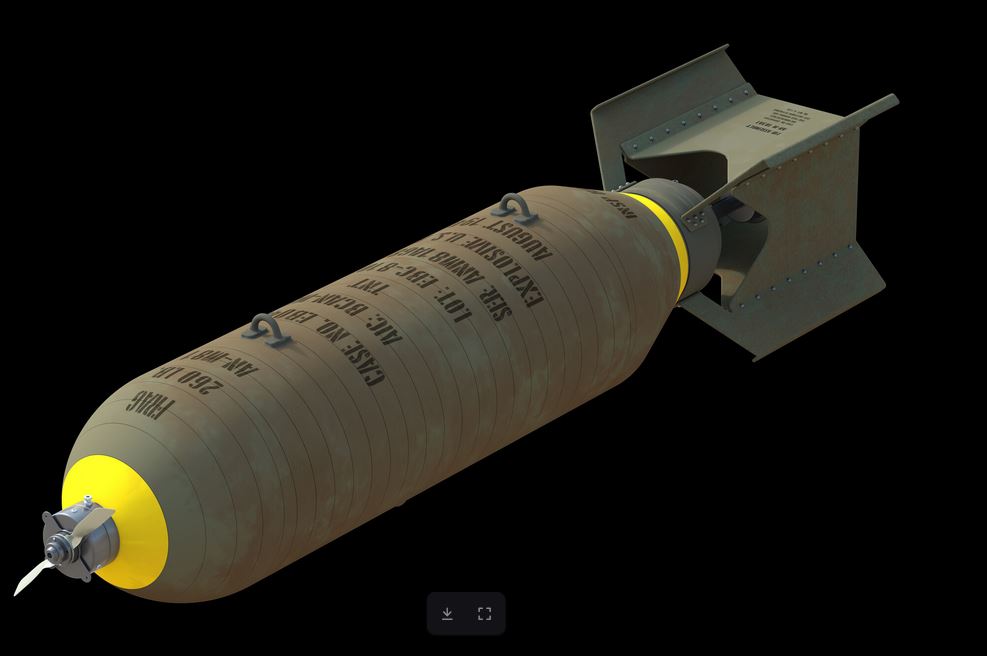
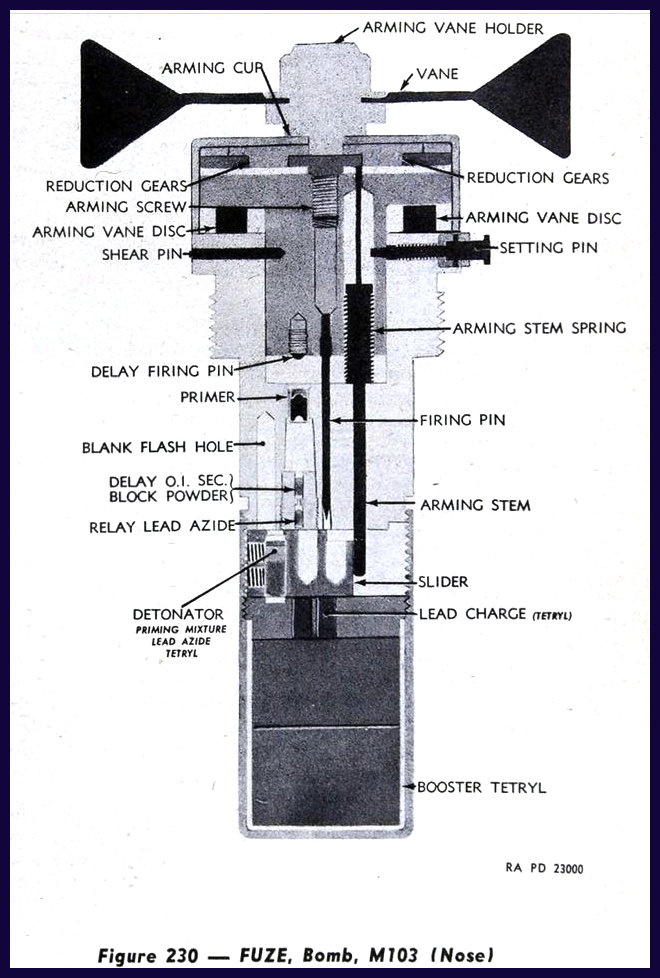
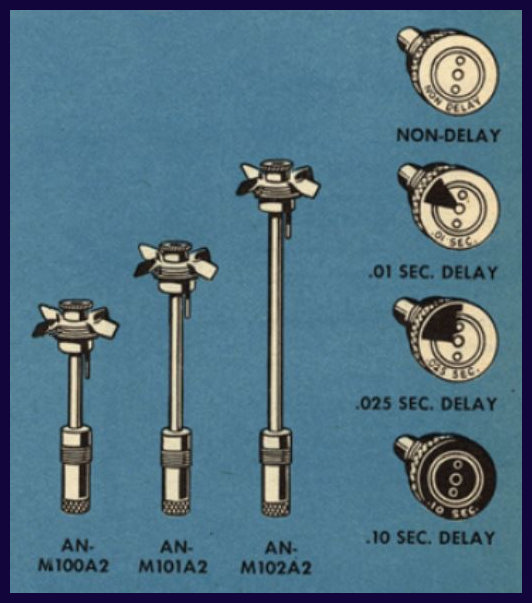
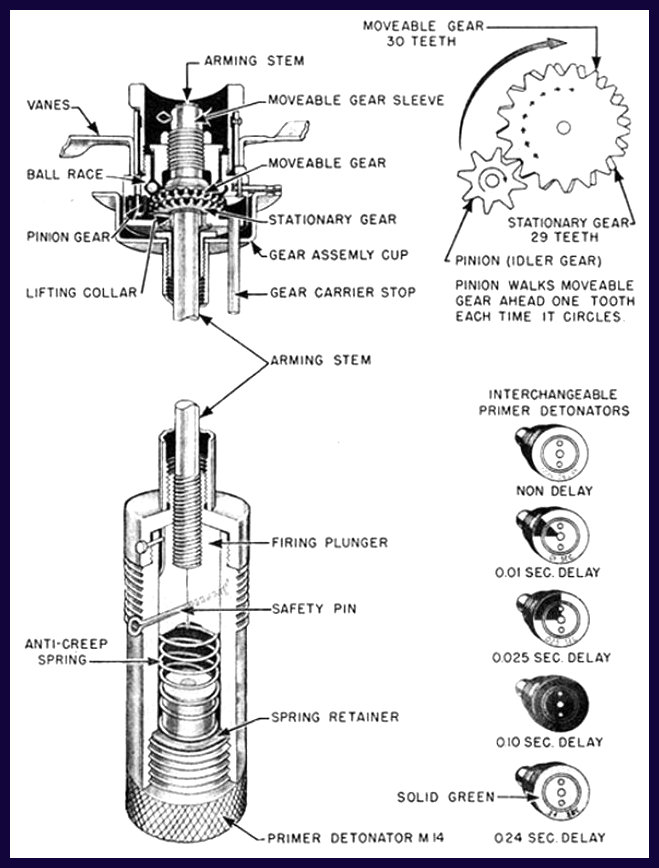
BOMBE US 20 lb frag AN-M41
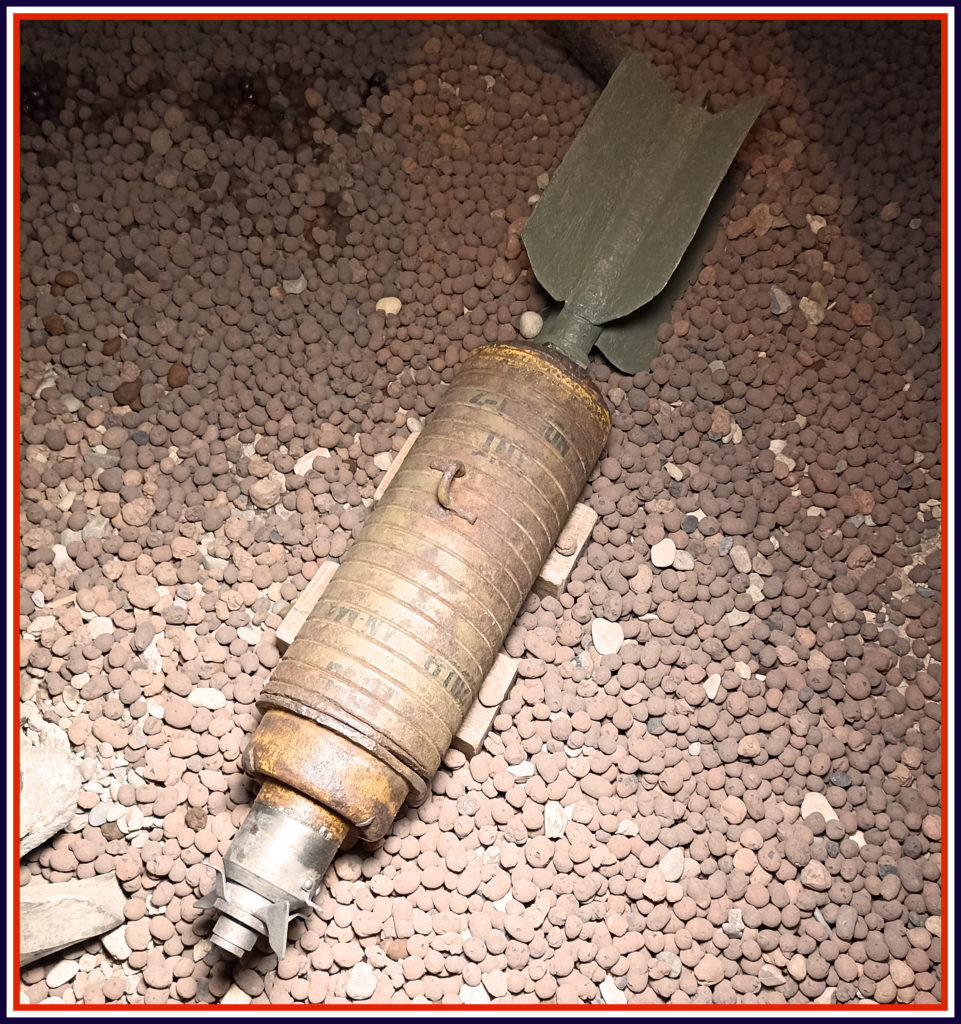
American 20 lb (9.07 Kgs) frag AN-M41 high-explosive (HE) fragmentation bomb.
This bomb features a cast steel nose and tail, and a drawn steel wire (serpentine) wound helically around the tube, which explodes into dozens of infantry-killing fragments.
The nose of the bomb is threaded to accept an AN-M110A1 impact fuse (replacing the M109).
Approximately 13% of the bomb’s weight (1.2 Kgs) is made up of explosive charges.
The bomb can be released in a cluster of six bombs in the AN-M1A1 cluster adapter.
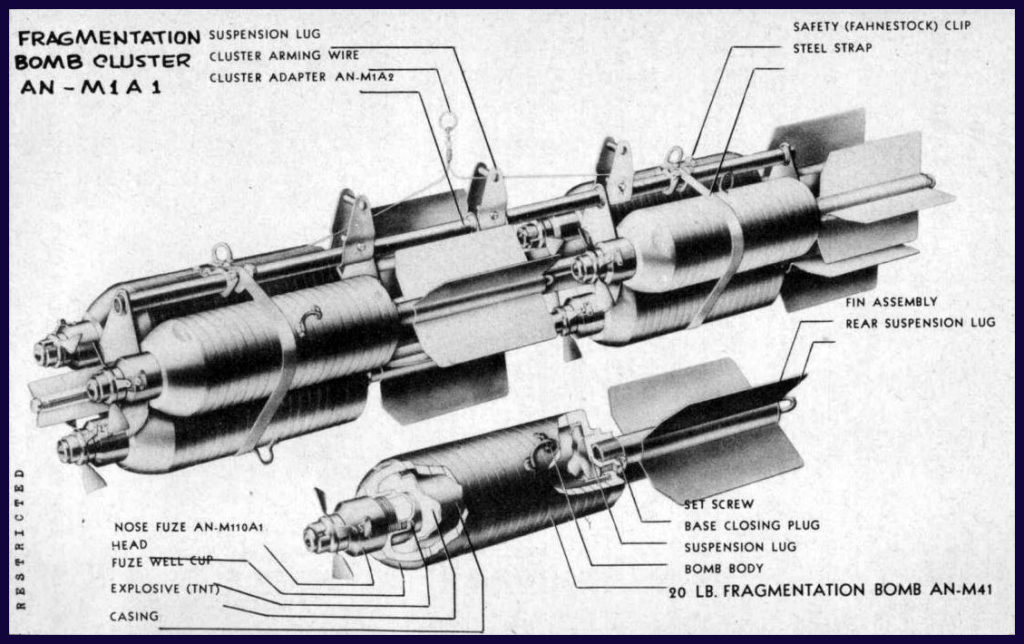
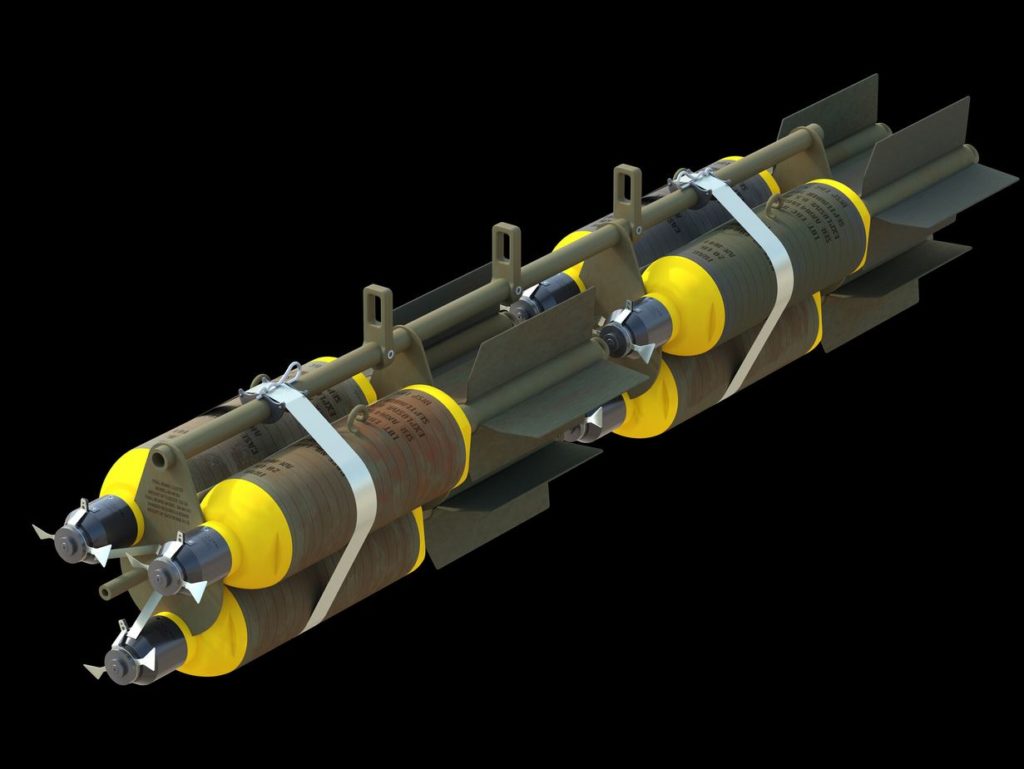
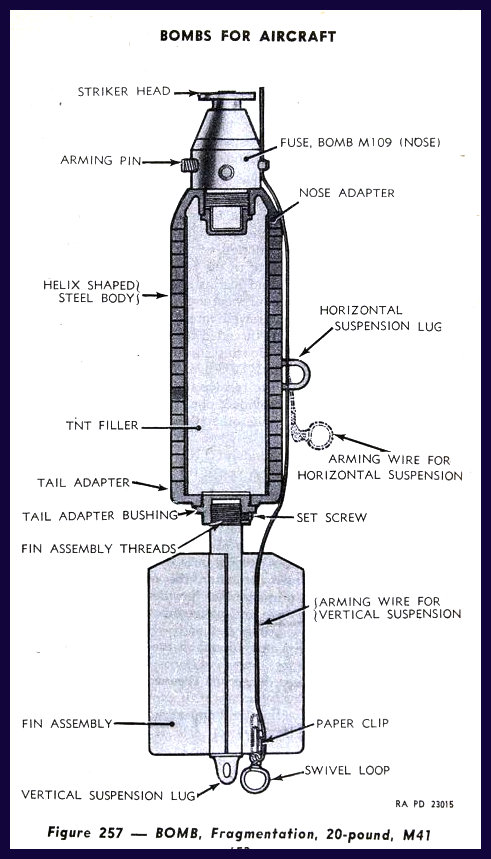
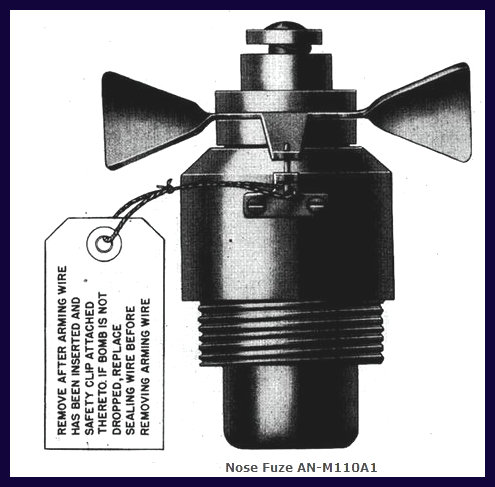
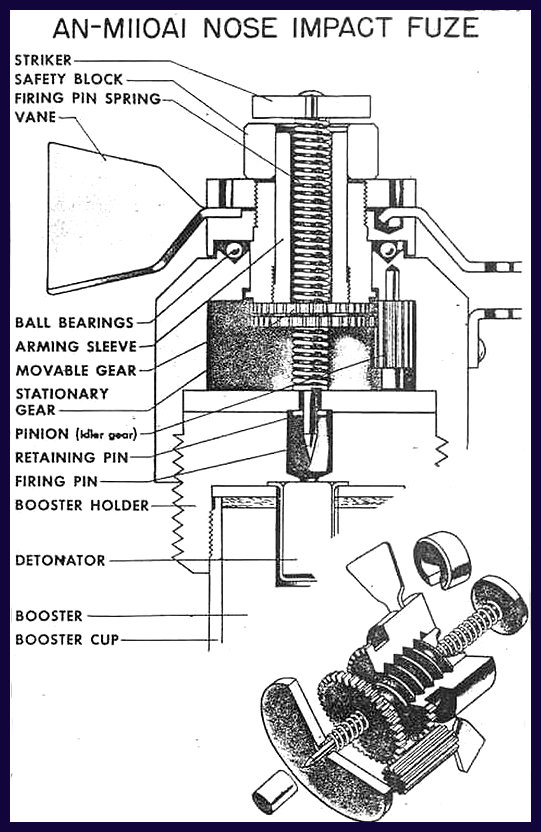
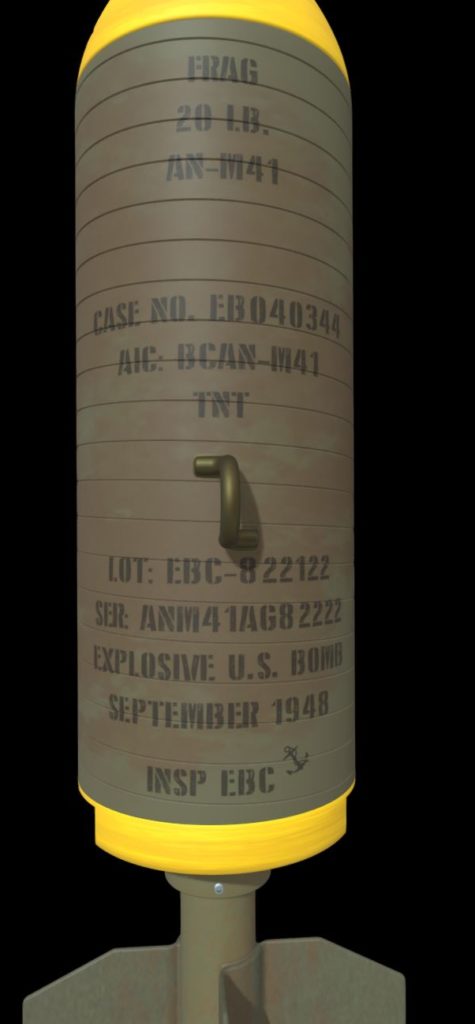
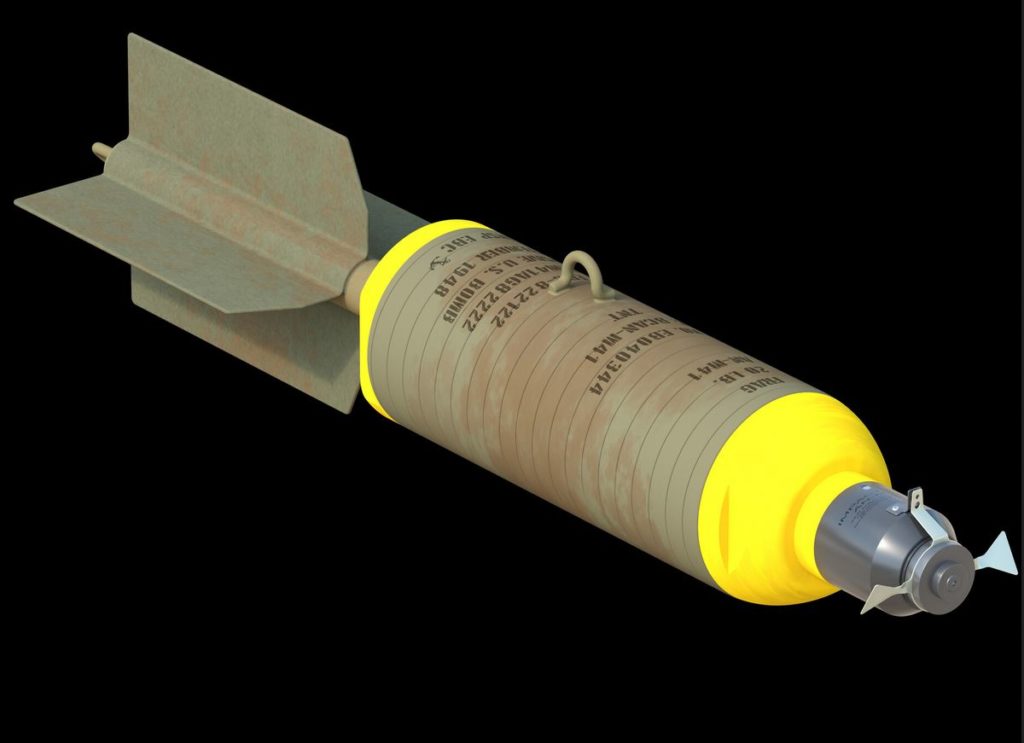
Albert Cecil GOURE 1919 – 1957
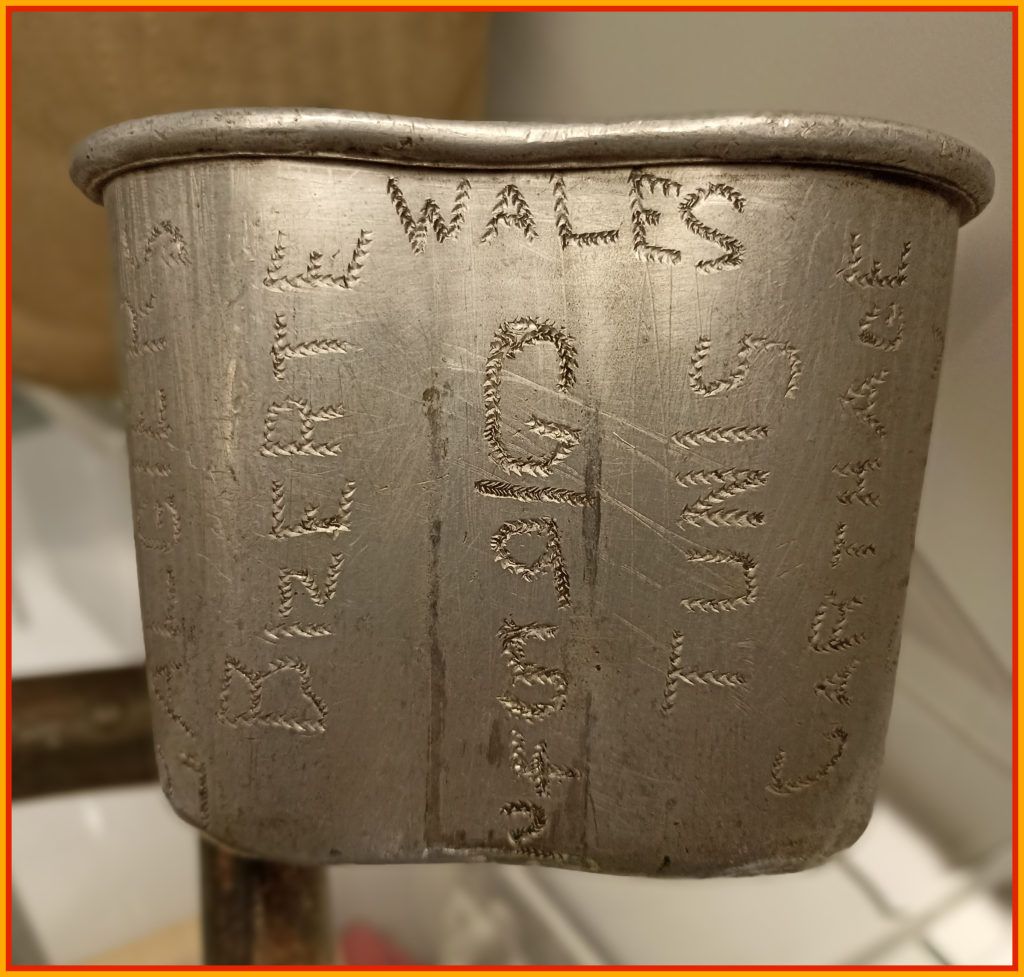
On this American quarter manufactured in 1942 by A.G.M Co. are engraved the following places: SCOTLAND – WALES – ENGLAND – LIVERPOOL – LONDON – AFRICA – ORAN – ALGIERS – BIZERTE – TUNIS – CARTHAGE – SICILY – PALERMO – ITALY – NAPLES – ROME – POMPEIS – FRANCE and a Landry Number G9542…which corresponds to the initial of the soldier’s surname followed by the last 4 digits of his Army serial number.
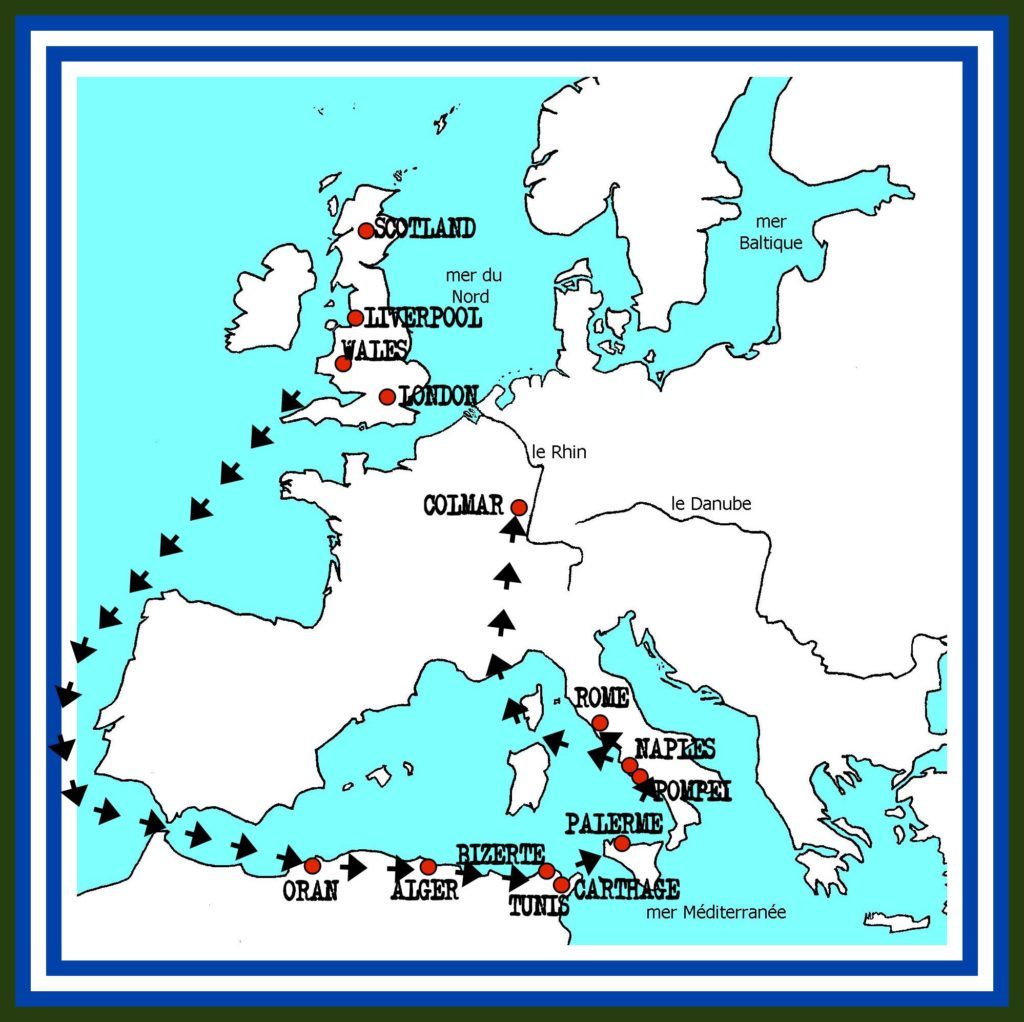
Thanks to the engraving of these few elements, we were able to find its “owner”.
Albert Cecil GOURE was born on September 29, 1919 in Oklahoma City, OKLAHOMA.
Before joining the army, he worked as a laborer in the textile industry.
He enlisted as a private on 06-03-1941 in the US Army under Army serial number n° 38019542 and ended the war with the rank of Staff Sergeant.
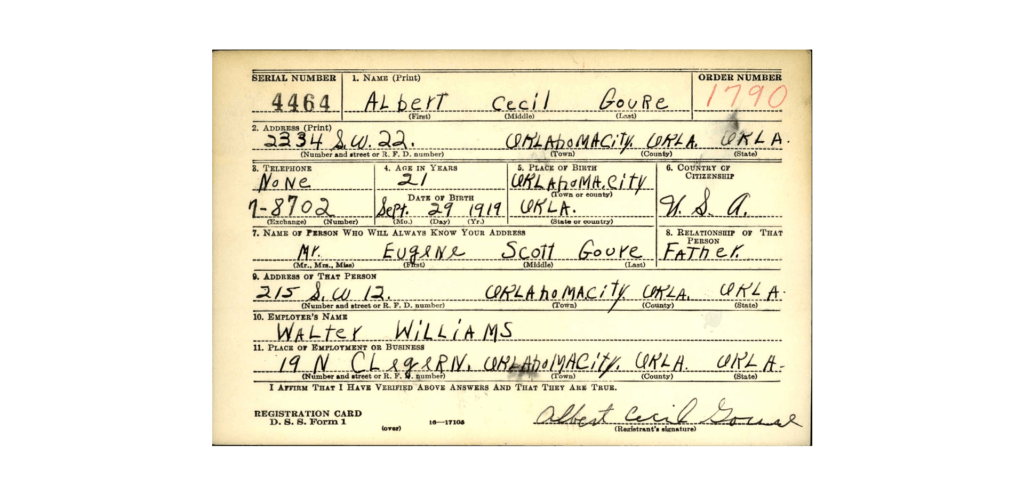
He served with the 10th Field Artillery Battalion “The Rock’s Support”, a divisional artillery unit of the US 3rd Infanty Division equipped with 105 mm HM2 guns.
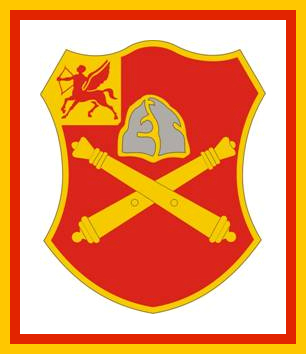
This is why he landed in Oran (Algeria) in November 1942 (from England) and not in Morocco like the rest of the US 3rd Infantry Division (from the USA) making up the Western Task Force, during Operation Torch (November 1942).
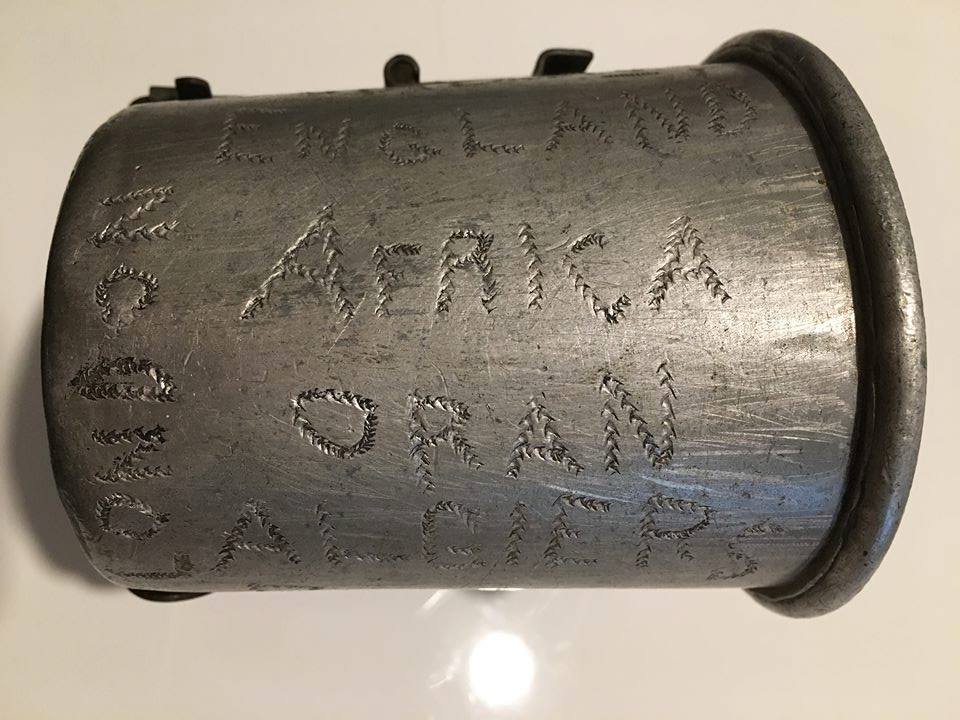
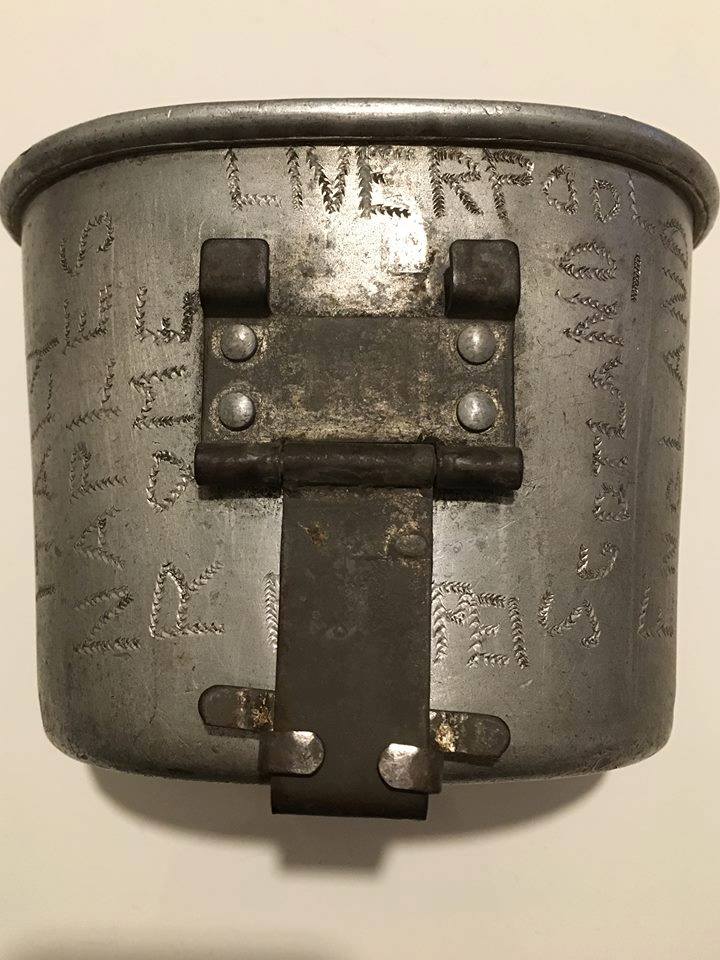

Its engravings trace its journey from England to North Africa, via Sicily, Italy and France.
This quarter was recovered a few days after the liberation of Colmar in February 1945 and carefully preserved throughout his life by Robert WIEDERHIRN, who was 11 at the time.
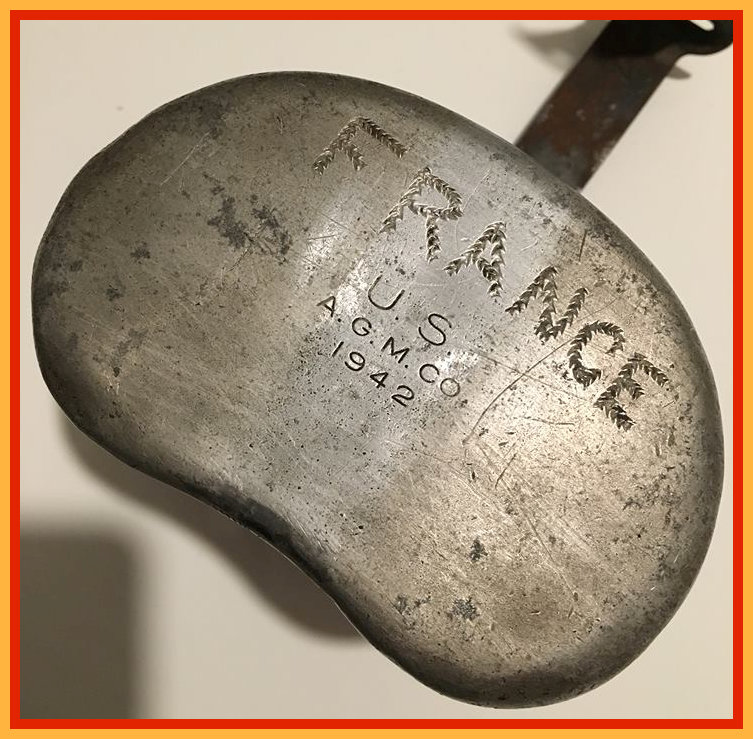
We thank his widow for entrusting it to us, so that we can take the greatest care of it and perpetuate the memory of Albert C. GOURE and his donor.
Albert C. Goure died on August 27, 1957 at the age of 37 in Kailua-Kona, Hawaii.

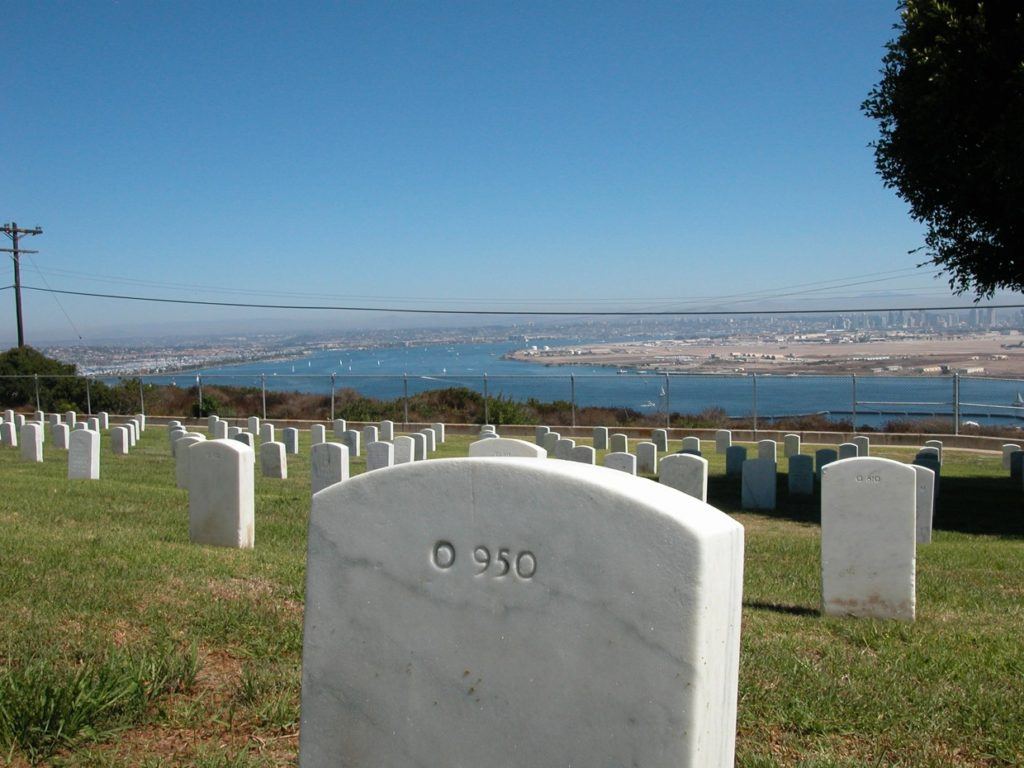
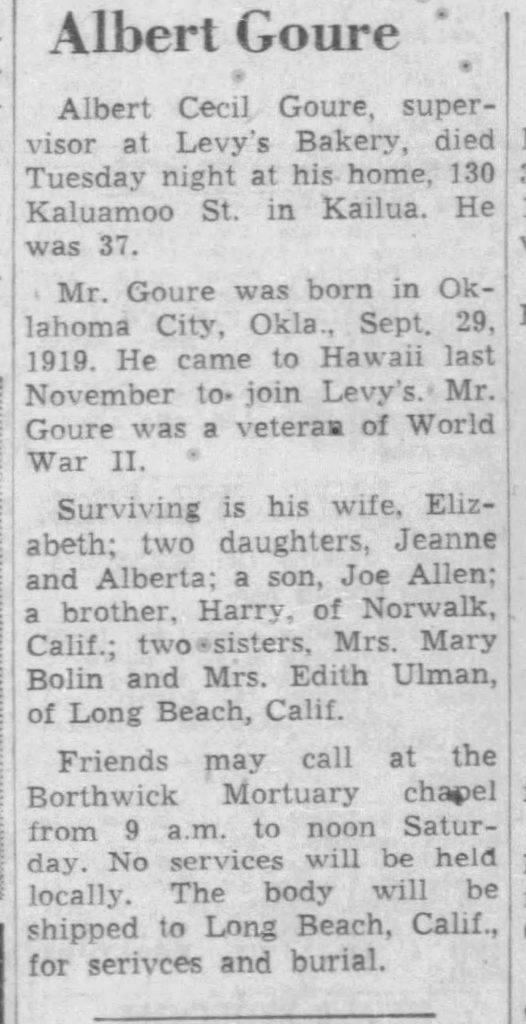
Richard Arthur Clark 1925 – 1978

In Memory of Richard A. CLARK and Trey CURINGTON.
On June 1, 2023 Mark Hatchel came from the USA (Texas) with a group of friends to bring to the Musée Mémorial an object from the collection of his regretted friend Trey Curington, who died of cancer on June 7, 2021 at the age of 53.
Trey wife’s wished to offer the Colmar pocket battle Memorial Museum an artifact from Trey’s collection : the bag of Richard A. CLARK who was in the 3rd American Infantry Division and took part in the liberation of Alsace.
Richard Arthur CLARK was born on January 8, 1925 in Saratoga Springs, New York.
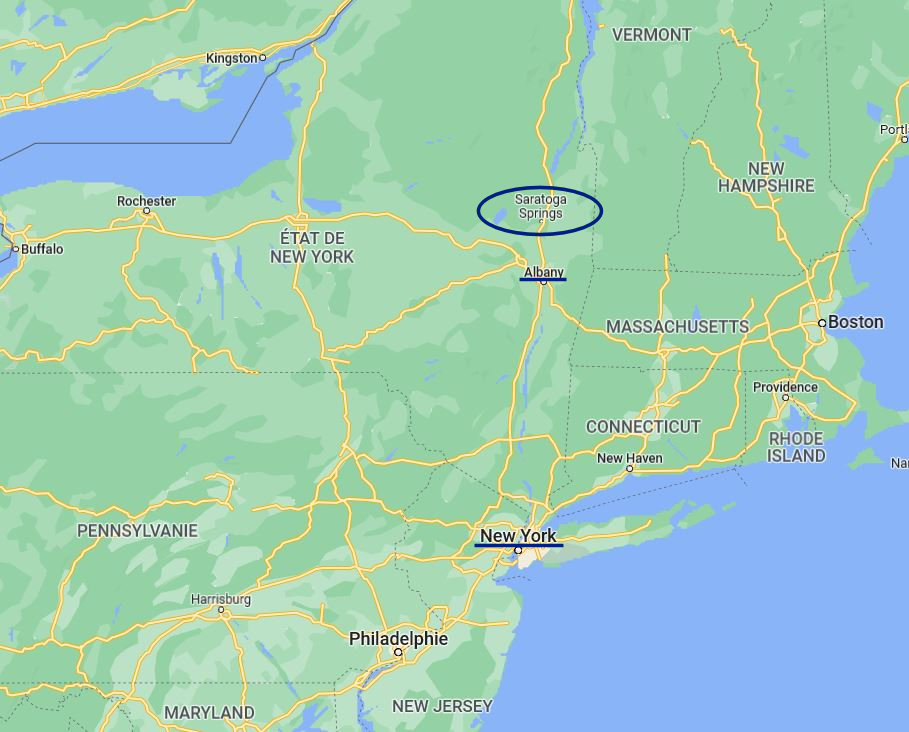
PVT (Private) Clark enlisted in the U.S. Army and joined the 3rd Infantry Division “Rock of the Marne”.
He was assigned to “The Cotton balers” of the 7th US Infantry Regiment, Company D, 1st Battalion’s heavy weapons company(heavy machine gun cal.30 + 81 mm mortar).
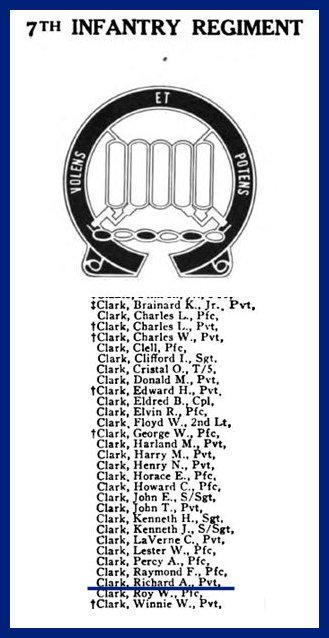
His Army serial number (ASN) is 32855887.
He took part in all the battles, from North Africa to Austria… as a souvenir, he marked his journey during the Second World War on his bag…
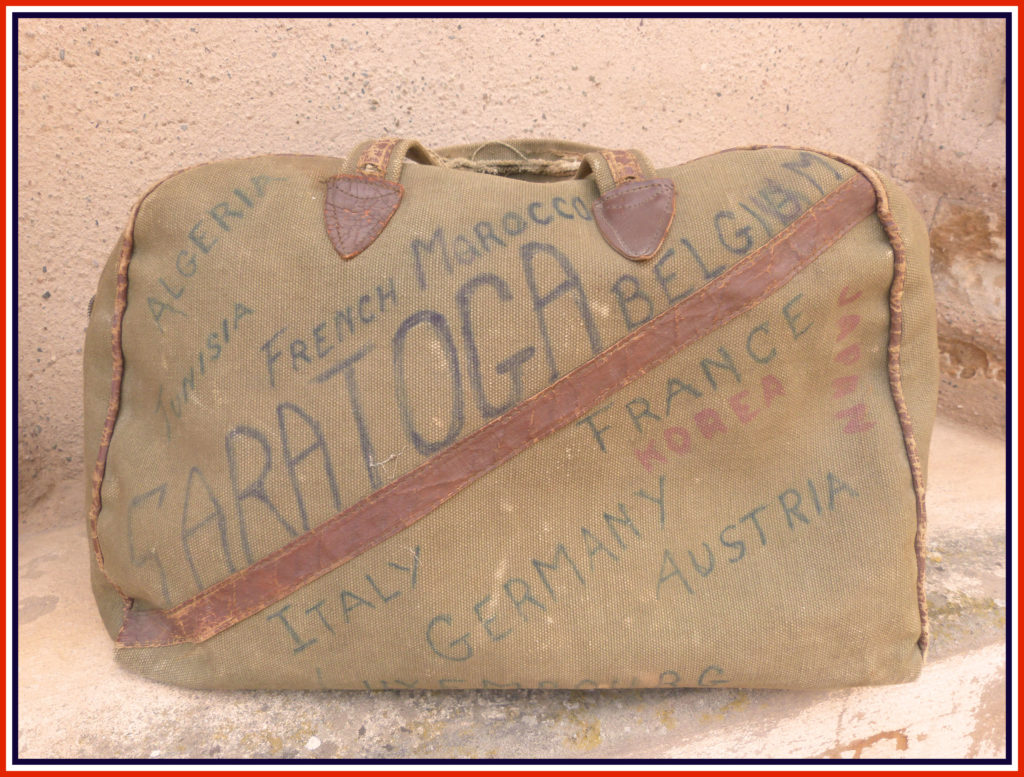
He was wounded for the first time in January 1944 in Italy by a bullet in the brachial muscle (between the humerus and the elbow). Exact date and place unknown to date.
He was wounded again in action in Italy, in May 1944 by shrapnel to the thigh and arm. After convalescing, he rejoined his unit in August 1944.
He left the 3rd Infantry Division in December 1947…
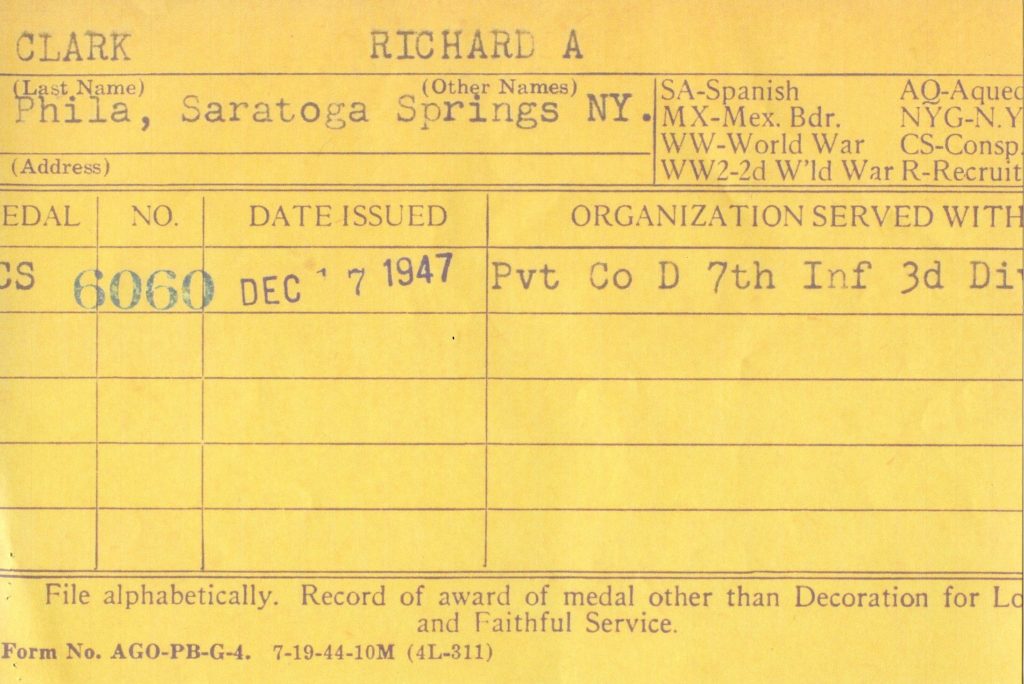
He also fought in the Korean War. He left the army with the rank of Staff Sergeant (SSGT).
Richard A. CLARK died at the age of 53 on February 4, 1978, and is buried at Saint Peters Cemetery in Saratoga Springs.
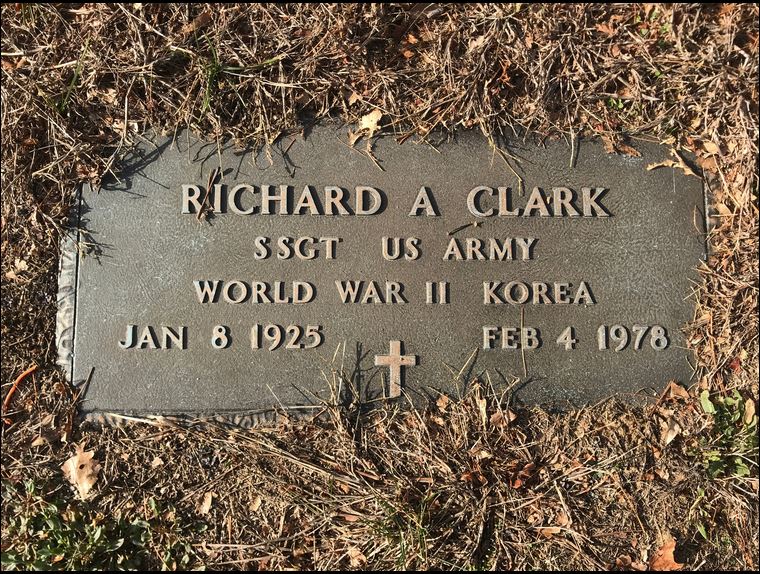
He was married to Doris M. Le VOY, who joined him in 2015 (22/10/1934 – 11/01/2015).
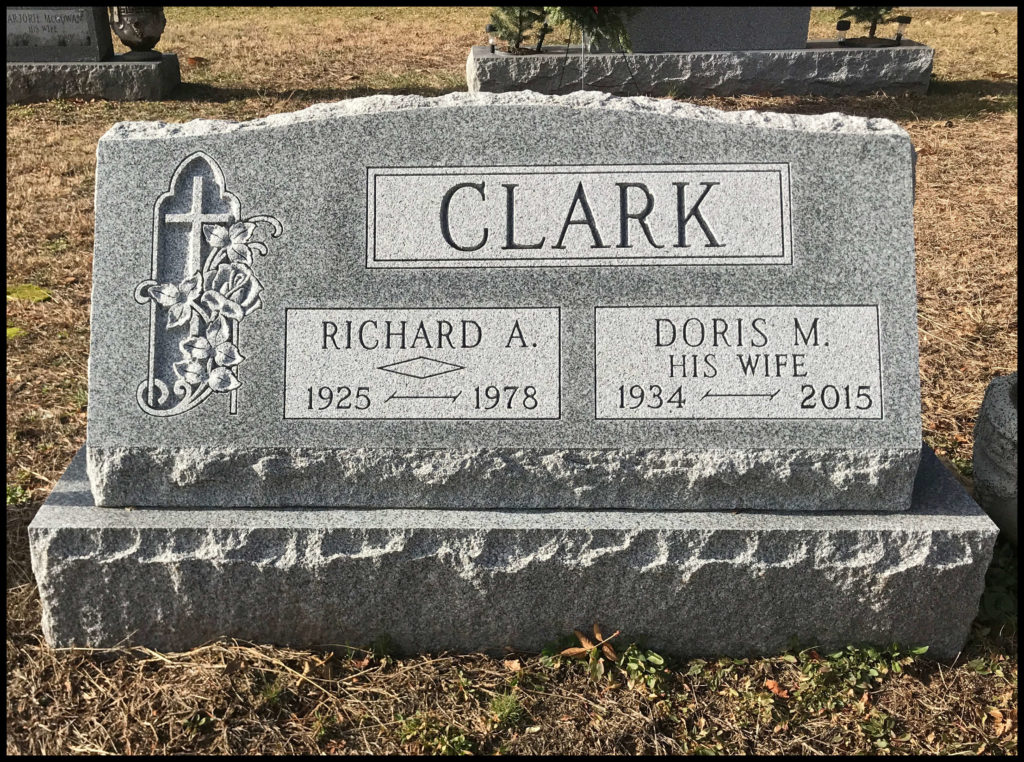
We sincerely thank Mark, as well as Trey’s wife and family, for this generosity, and pledge to perpetuate the memory of our liberator Richard A. Clark and Trey Curington, who throughout his life made many contacts with World War II veterans to collect their testimonies and pass them on to future generations.
IN MEMORY OF TREY CURRINGTON
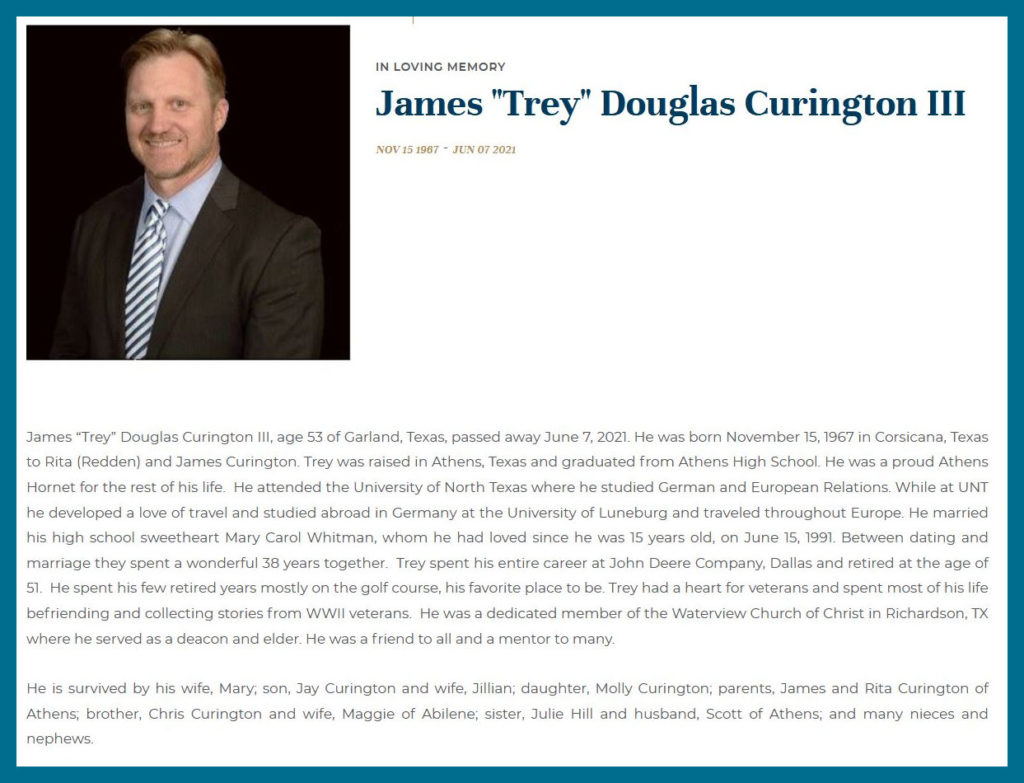
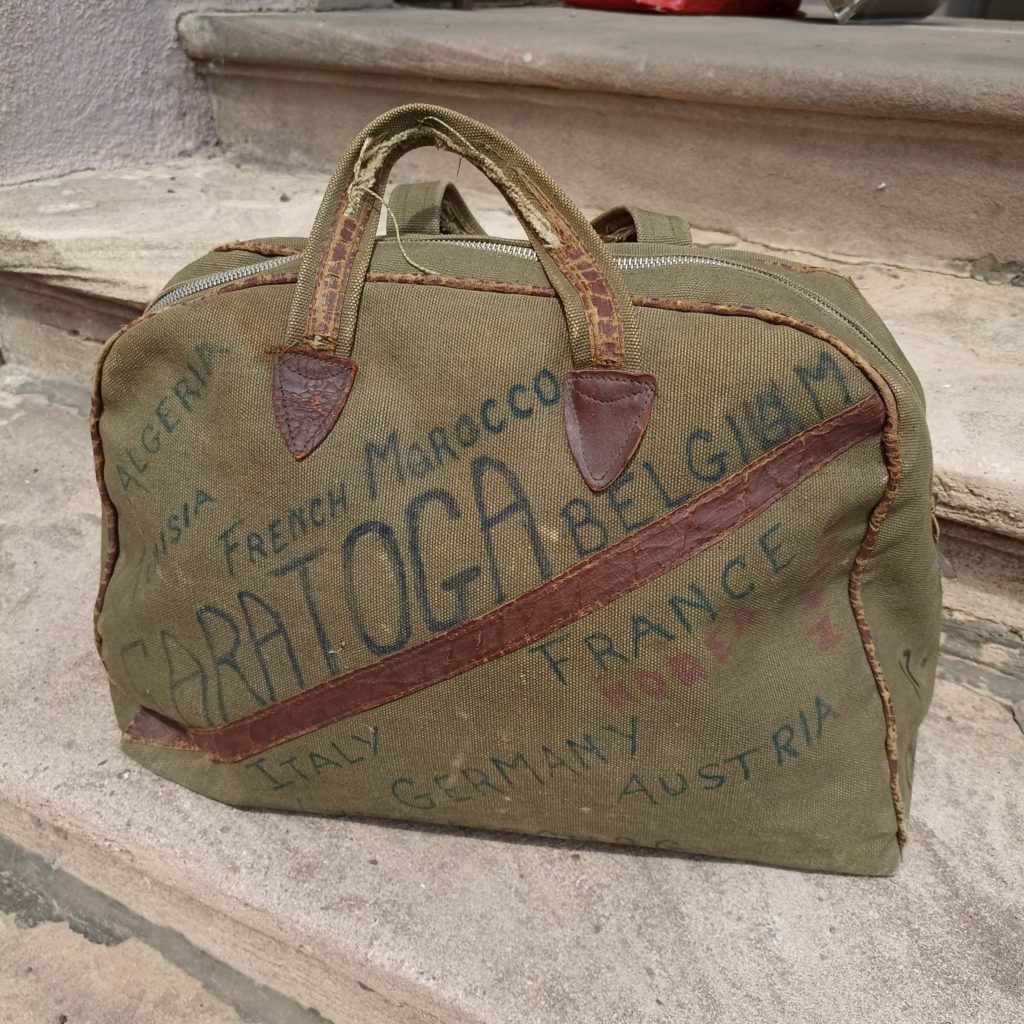
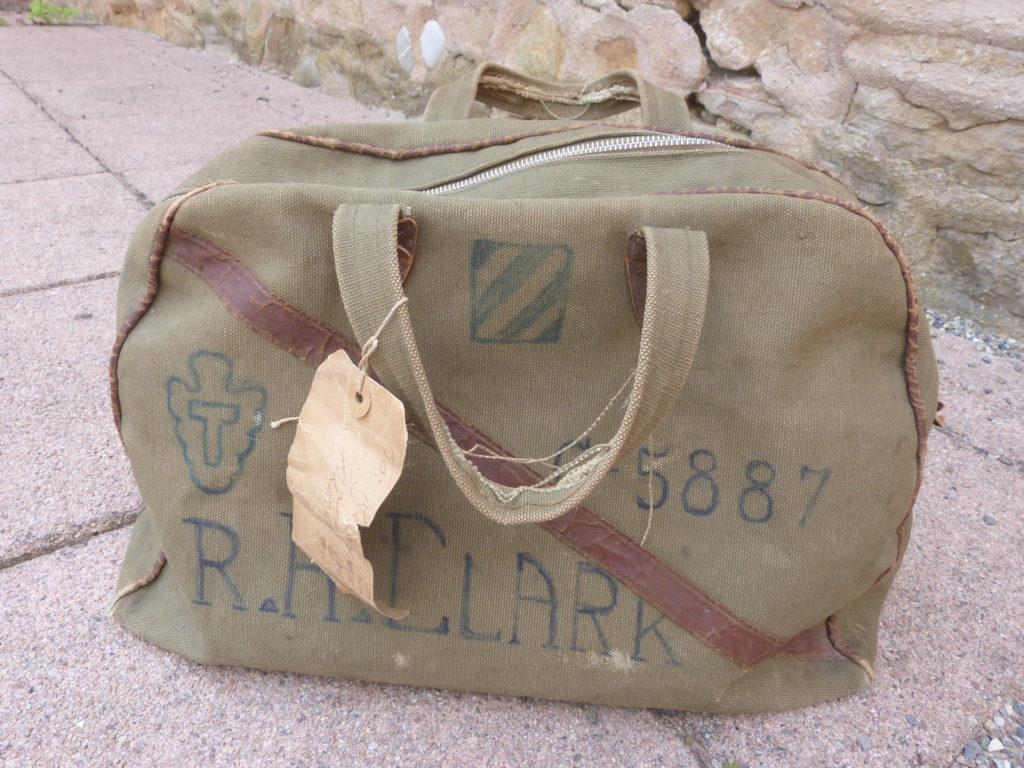
He drew a 36th ID insignia on his bag, but we have no explanation for this (research in progress).
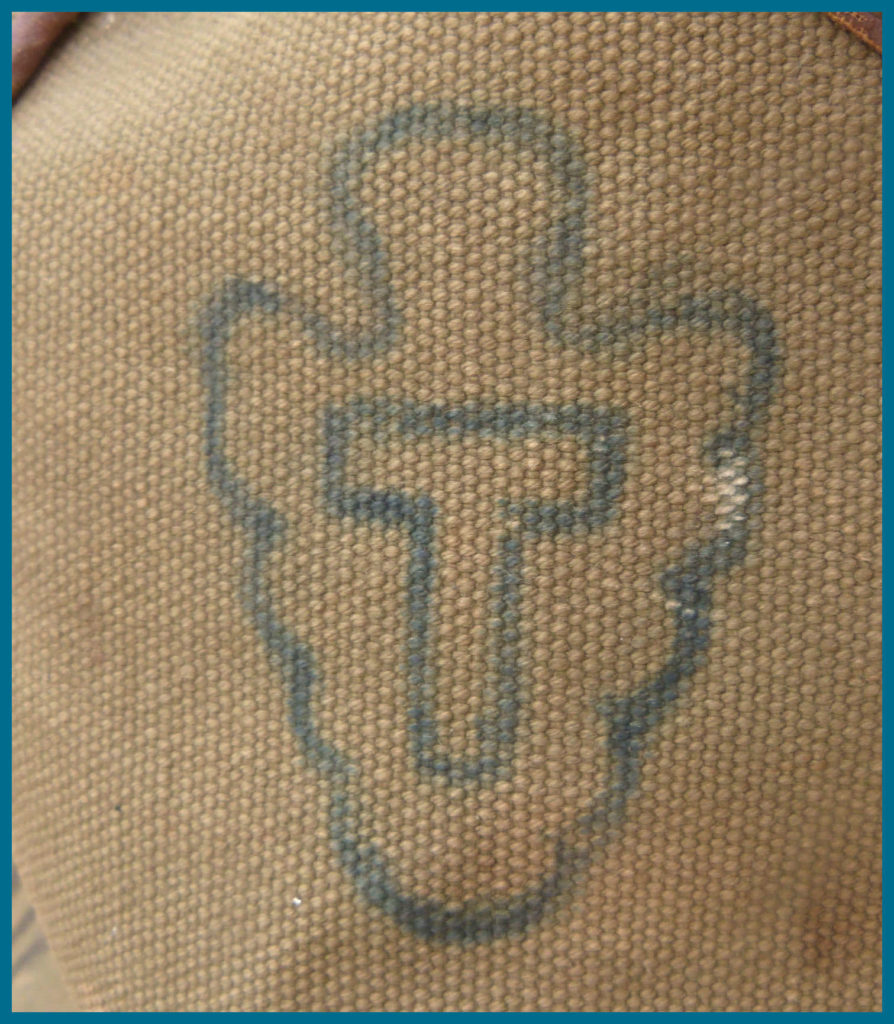
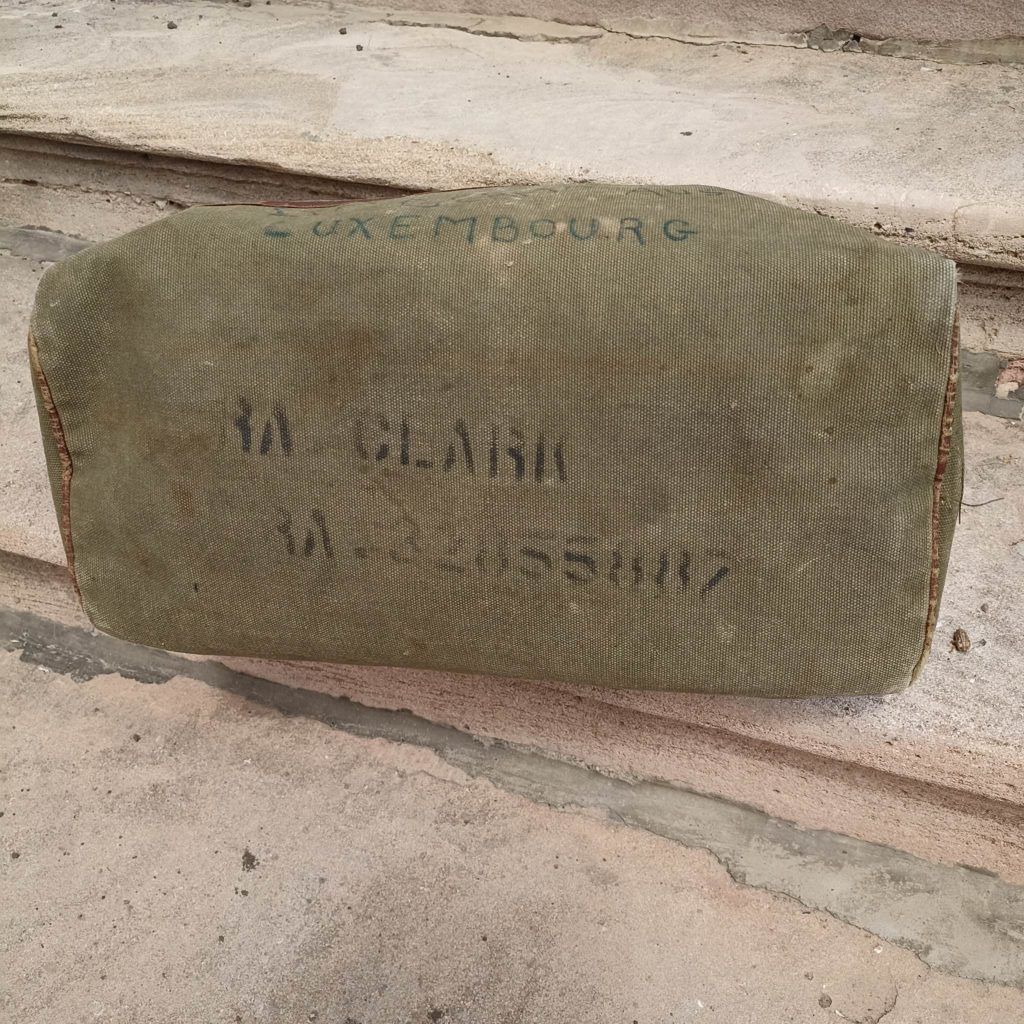
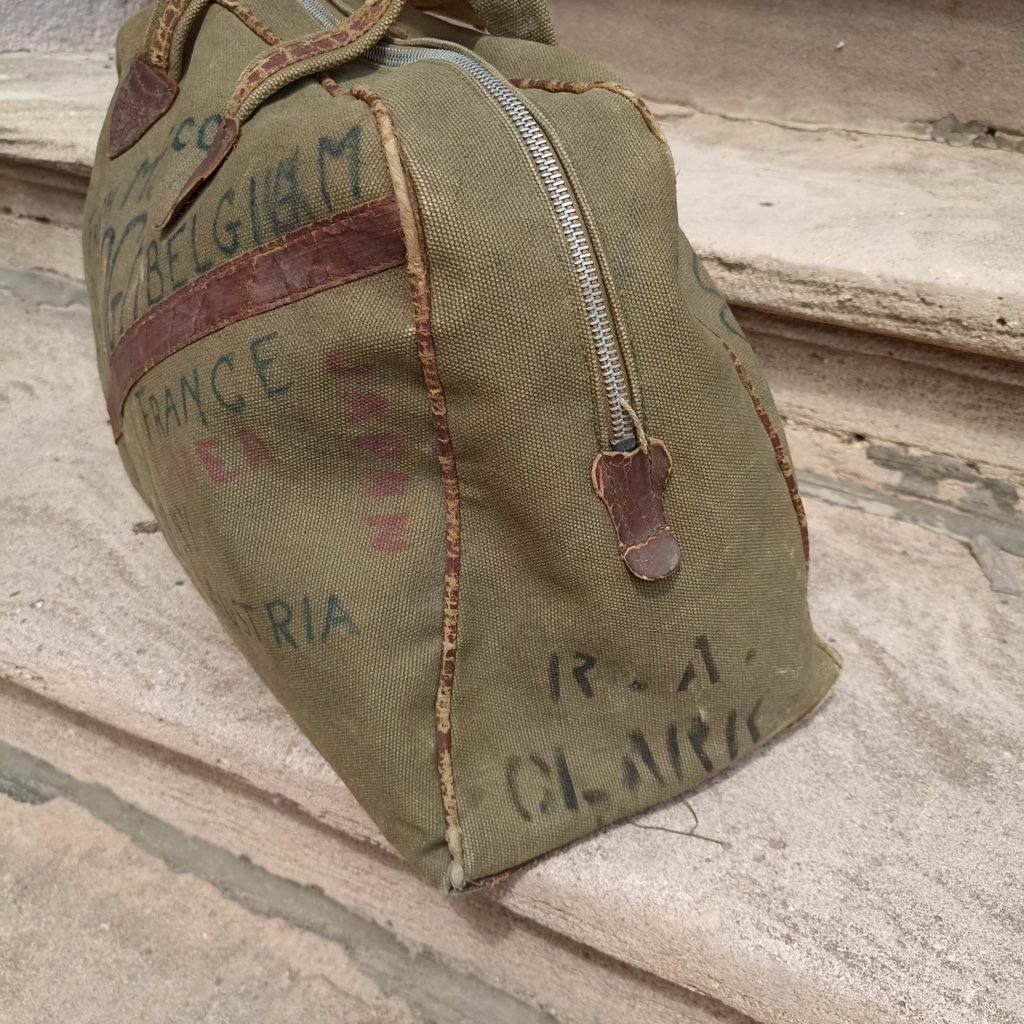
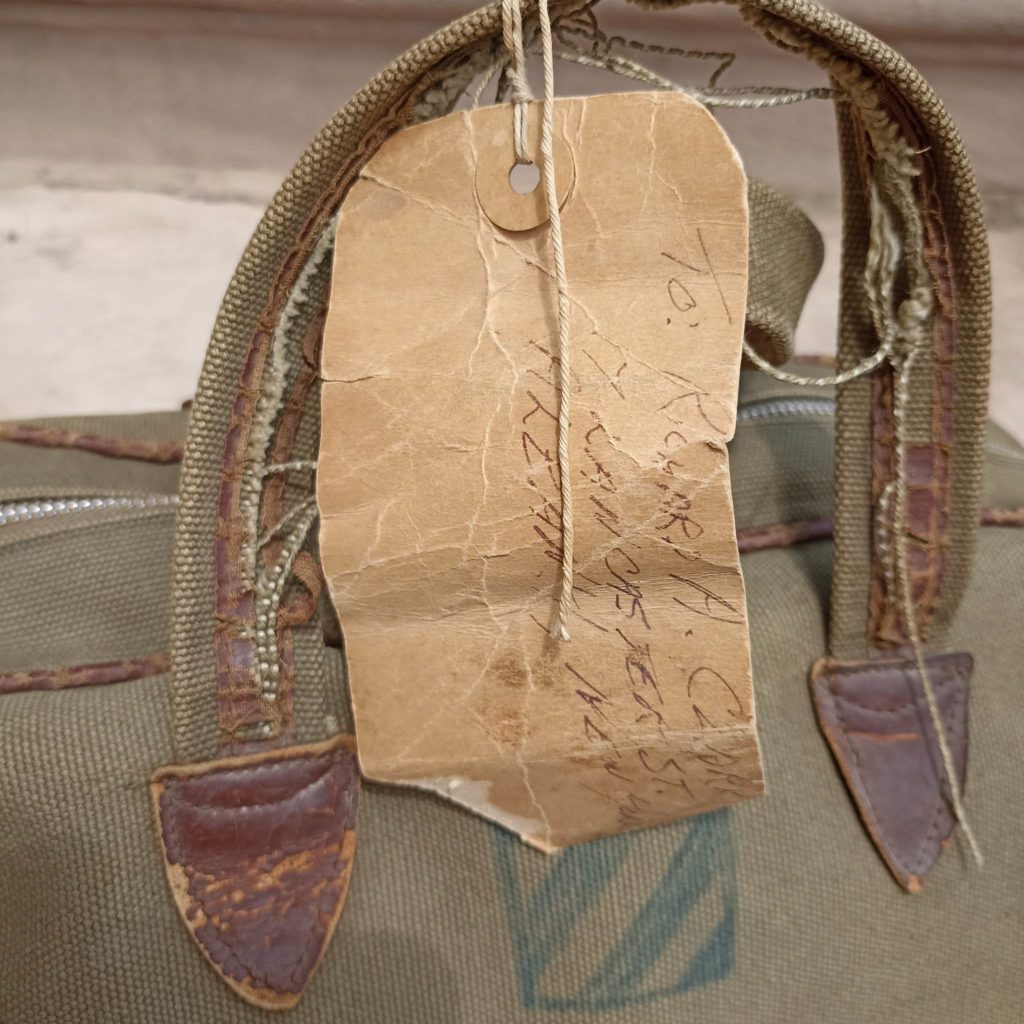
Abner CHERKI 1924 – 2020
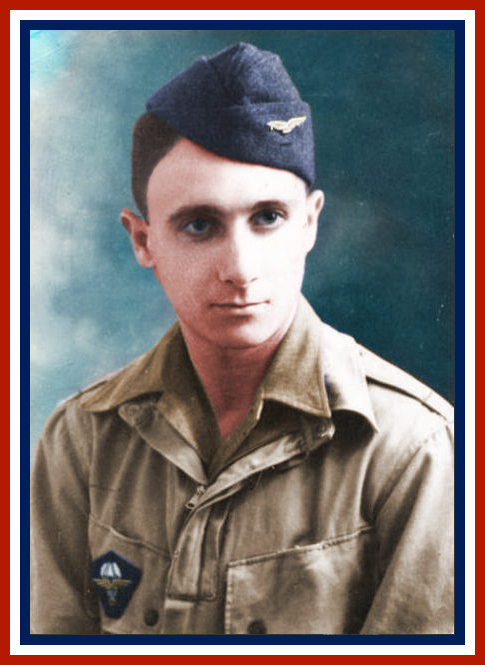
Young Abner Messaoud CHERKI was born in Algiers on December 20, 1924.
One of a family of 9 brothers and sisters, his father, Aizer CHERKI, was a prominent North African spice merchant and war veteran (Staff Sergeant in the Army Medical Corps) who served in the Ardennes, as well as in the Levant (Egypt, Palestine, Lebanon and Syria) between 1913 and 1919. He lost two of his brothers in the trenches.
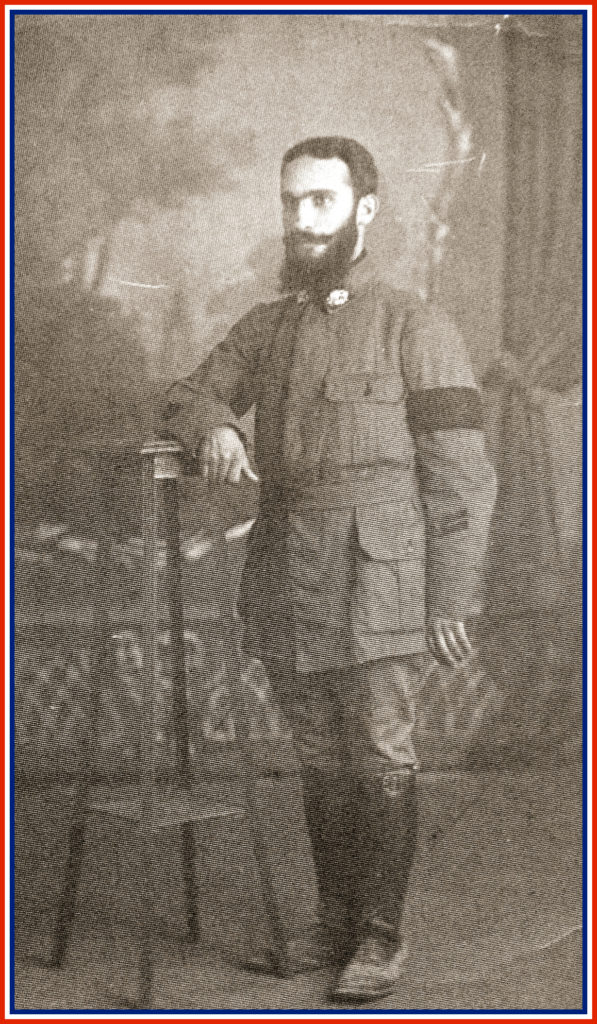
Holder of a Certificat d’Etudes Primaires (CEP), the diploma that validated the end of elementary primary education in the 1930s.

He began working as a sales clerk for his father.
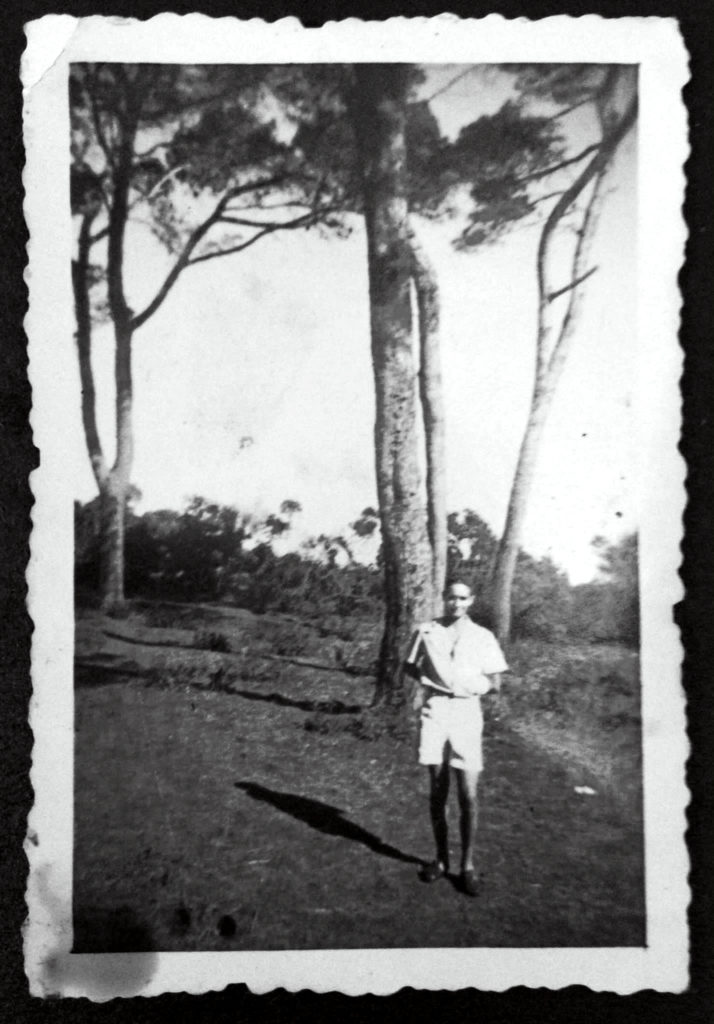
Born into a religious Jewish family, he fell in love with a girl 4-5 years younger than himself, Marcelle Sourgnes, an orphan, whom he met at the Eclaireurs Israélites de France (Du scoutisme juif à la Résistance (sdv.fr) where he was very active.
Abner’s totem name is “Loupcoquet” (Coquettish wolf).

Unfortunately, the families object to this relationship, but Abner persists.
Throughout the war, thanks to a mutual friend named Lison, he continued to correspond with her…despite the distance, the intervention of the families, the war, the joys and sorrows…
Marcelle and Abner were married on May 14, 1948…
…and remained inseparable until Abner’s “last jump” (as parachutists say) after more than 72 years together.
Having a “comfortable” life, it wasn’t written in advance that Abner would have to go and fight.
But this was not to know this young man, a great patriot, courageous and with a strong character, who could not accept that his country, France, could be occupied by a foreign power.
A child of North Africa, having been forced to travel several times to France for medical treatment during his childhood, it was essential for him to go and fight, to cross the Mediterranean again to liberate his compatriots from the Nazi yoke.
Against the advice of his family, he decided to enlist in the French army to take part in the Liberation of France.
Before he turned 18, he forged his father’s signature and enlisted.
As he began his training in the artillery, he was sent back to Algiers by his adjutant, who told him: “Come back when you’re 18!
At 19, in anticipation of his call-up, he enlisted at the Oudja Air Incorporation Office with the mobilization class of 1943 (he was class 1944).
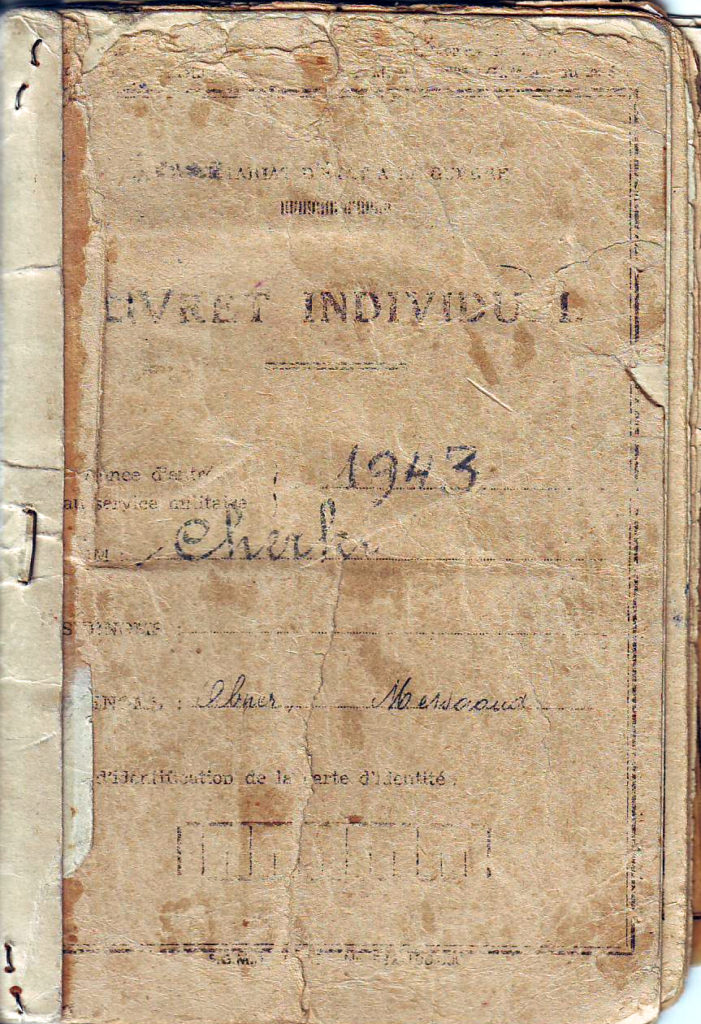
He was assigned to the Centre Instruction Infanterie n°1 (CII) in Mouzaïaville (near Blida – today = Mouzaïa), where he arrived on October 15, 1943 and stayed until December 11, 1943.

He was posted to the 1st RCP on 12/12/1943 (he crossed the Algerian-Moroccan border on 12/10/1943) and joined the regiment the same day at Oudja in Morocco.
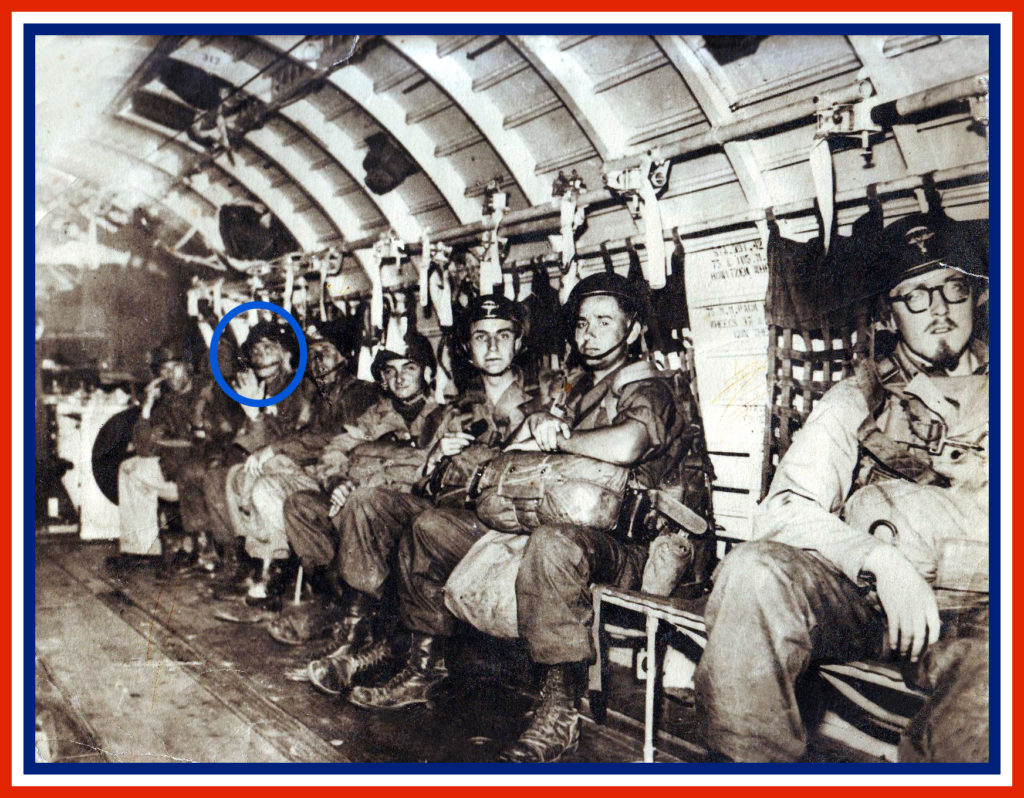
Three days before his 19th birthday, he was certified by the Americans on December 17, 1943, following his training at the Airborne Training Center (ATC) Parachute School of the 82nd US Airborne, which awarded him his certificate.
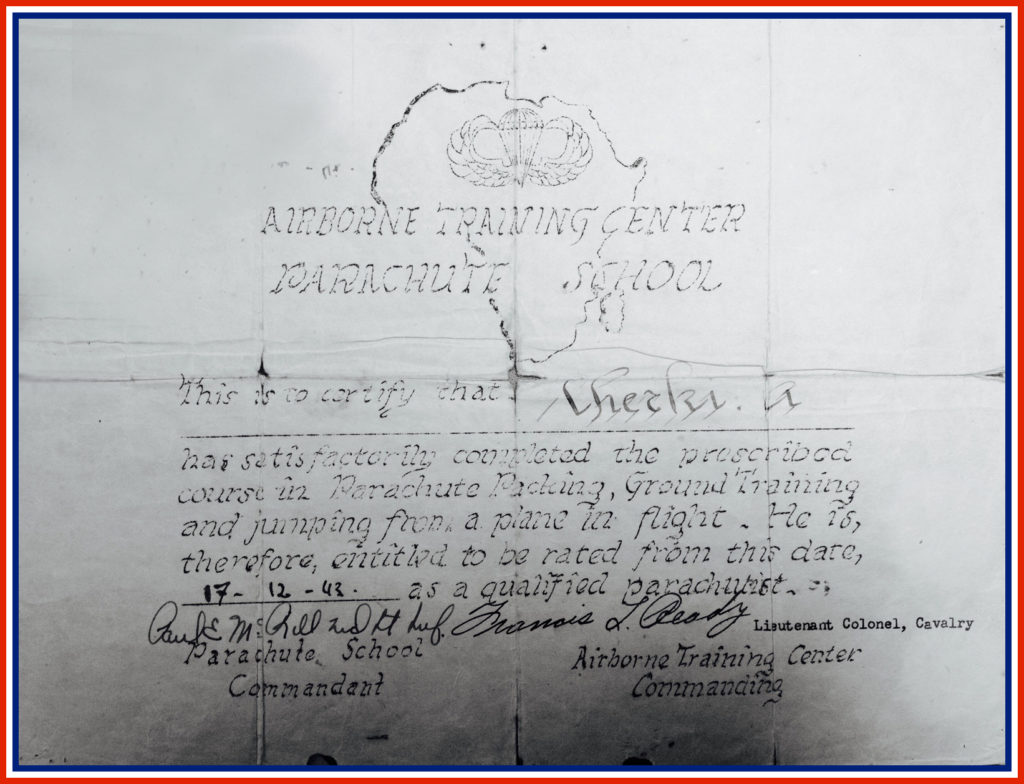
On the French side, he obtained his “Brevet Militaire d’aptitude aux fonctions de parachutiste de l’Infanterie de l’Air” on January 3, 1944: patent no. 1651.
On one of his many jumps, his main parachute failed to open (“torch”), but fortunately his reserve ventral parachute opened… and he lost several teeth.

He was assigned to the 6th Company (2nd Battalion) on January 11, 1944.
The 6th Company was part of the 1st Battalion of the 1st RCP, along with the 3rd, 4th and 5th Companies.
Below are the pennants of the 6th Company, to which Abner Cherki belonged. For the record, it was made by nuns in a convent near Trapani in Sicily.
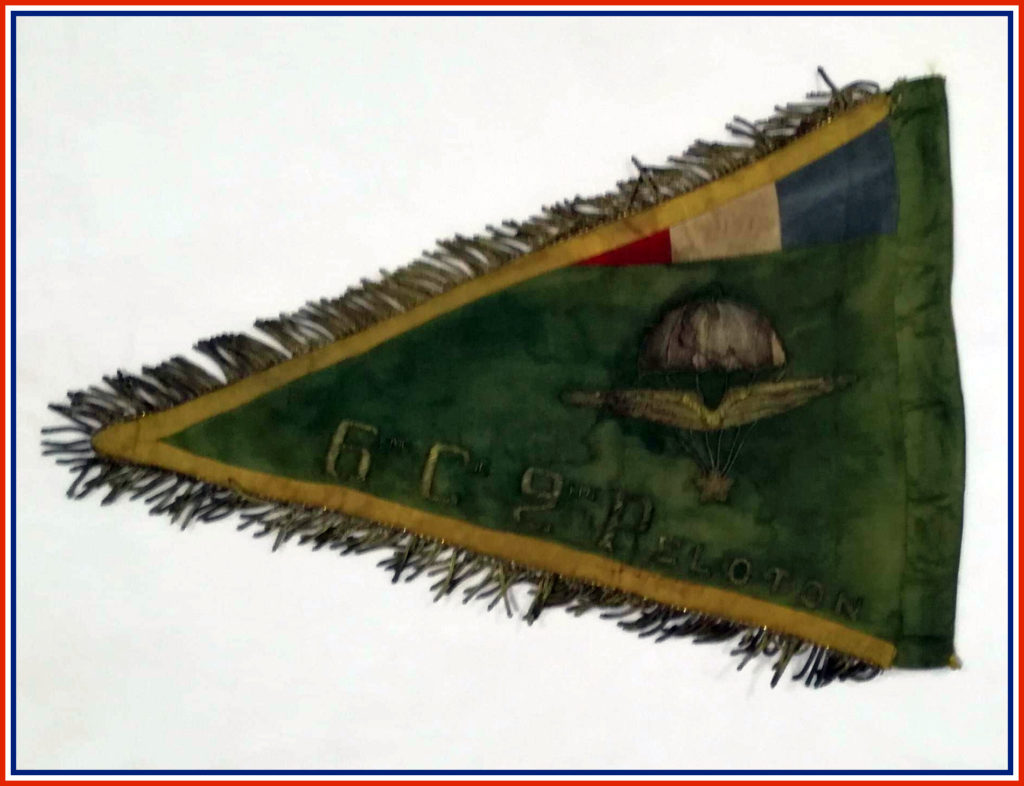
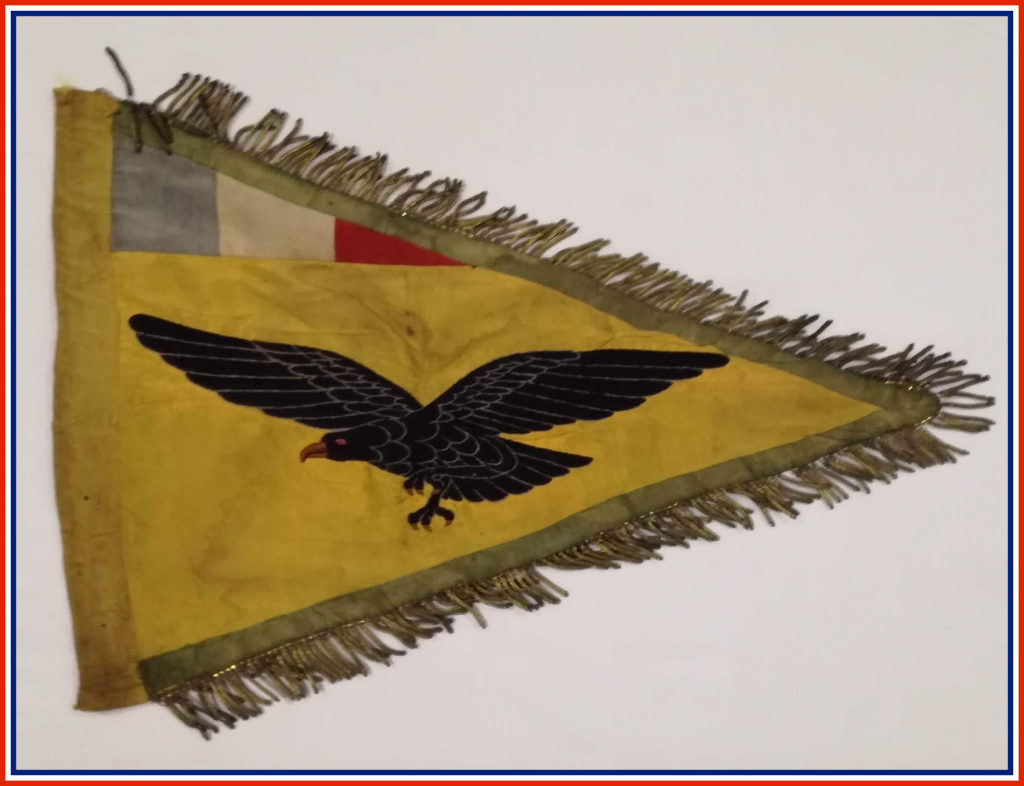
He landed in Sicily on April 5, 1944.
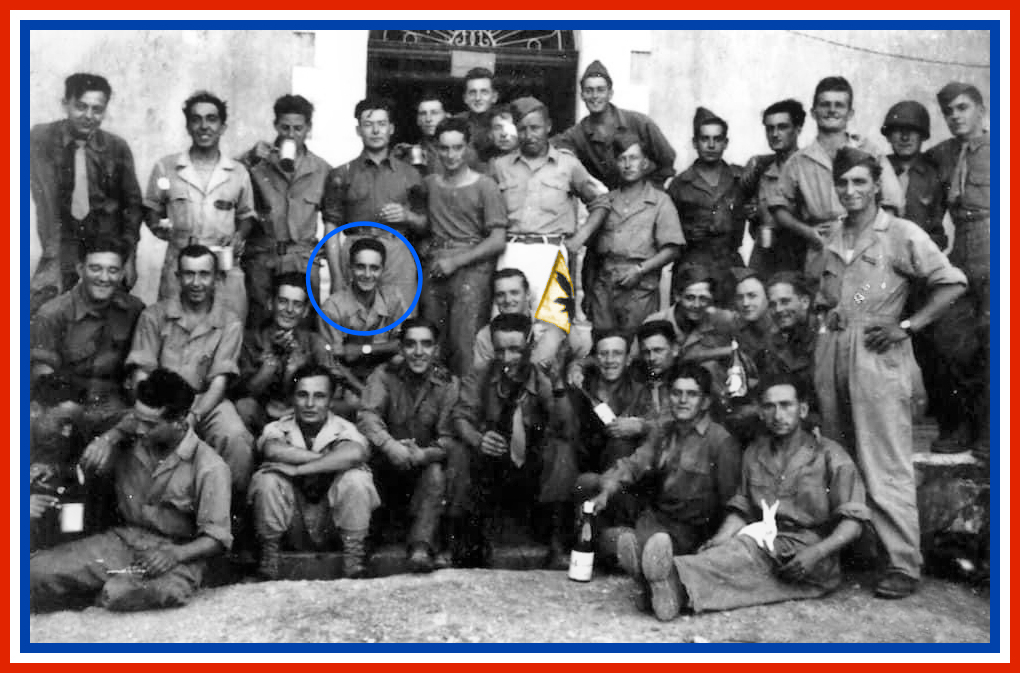
The 6th Company pennant can be seen in the center, with a small white rabbit in the lower right.
He arrived in France on September 5, 1944 at Valence-Chabeuil in the Drôme region, and took an active part in the Vosges campaign from October 3 to 21, 1944.
He took an offensive role in the fighting in the Longegoutte forest (Morbieux) on October 6, 1944, and in the Gehan forest (Ménil) on October 13, 16 and 20, 1944.
Despite the cold and harshness of the fighting in the Vosges, Abner recalled that “they ‘invited’ the German prisoners to sleep with them in the tents…those who refused were found the next day frozen to death”.
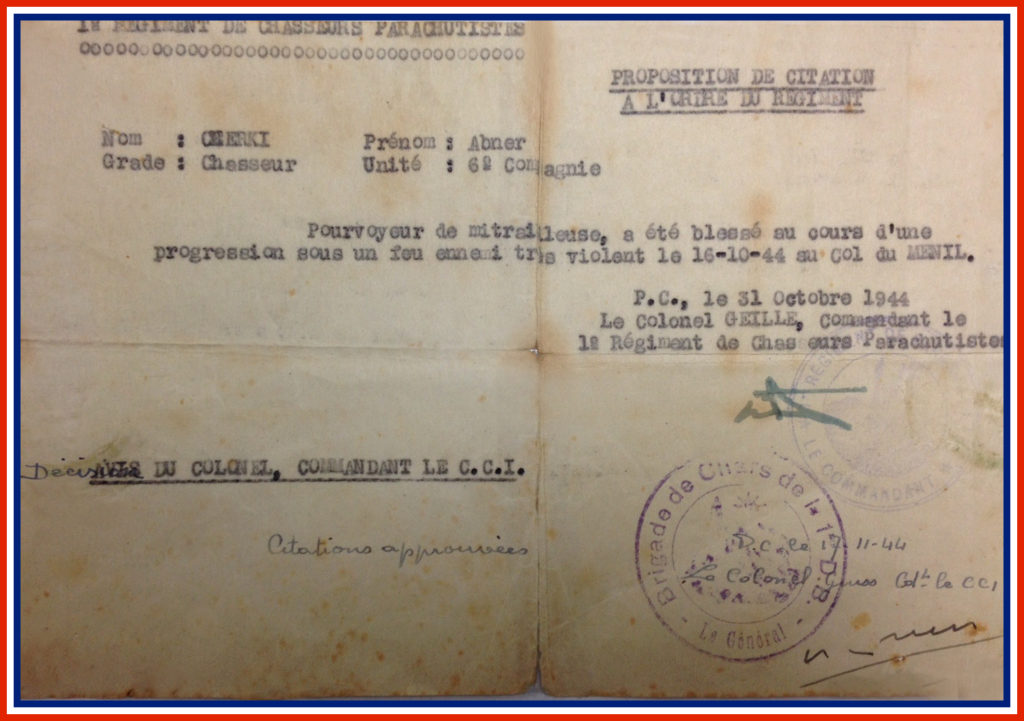
He was wounded on October 16, 1944 at Col du Ménil by shrapnel to the left shoulder, when mortar fire hit his company’s home base just before the planned assault, earning him a citation in the Regimental Order with Croix de Guerre 1939-1945 and Bronze Star.
After the war, Abner recalled that he could clearly hear the bullets whistling as he took up position behind the trees, and that the German soldiers were so close together that he could hear them talking.
“At 8am, the companies set off to cross the pass. The 3rd company’s mortars fired preparatory rounds on the German positions.
The 6th company was given a special mission: to seize a wood(square) south of the pass, which was to serve as a position for the 1st battalion’s Command Post(CP). When the 6th company set off, it came under heavy German machine-gun fire. The men continued to cross, encountering strong German resistance. The fighting in this wood was of a rare intensity, even going hand-to-hand.
However, the wood was cleared and the company moved in. For another 24 hours, it came under German artillery fire.”
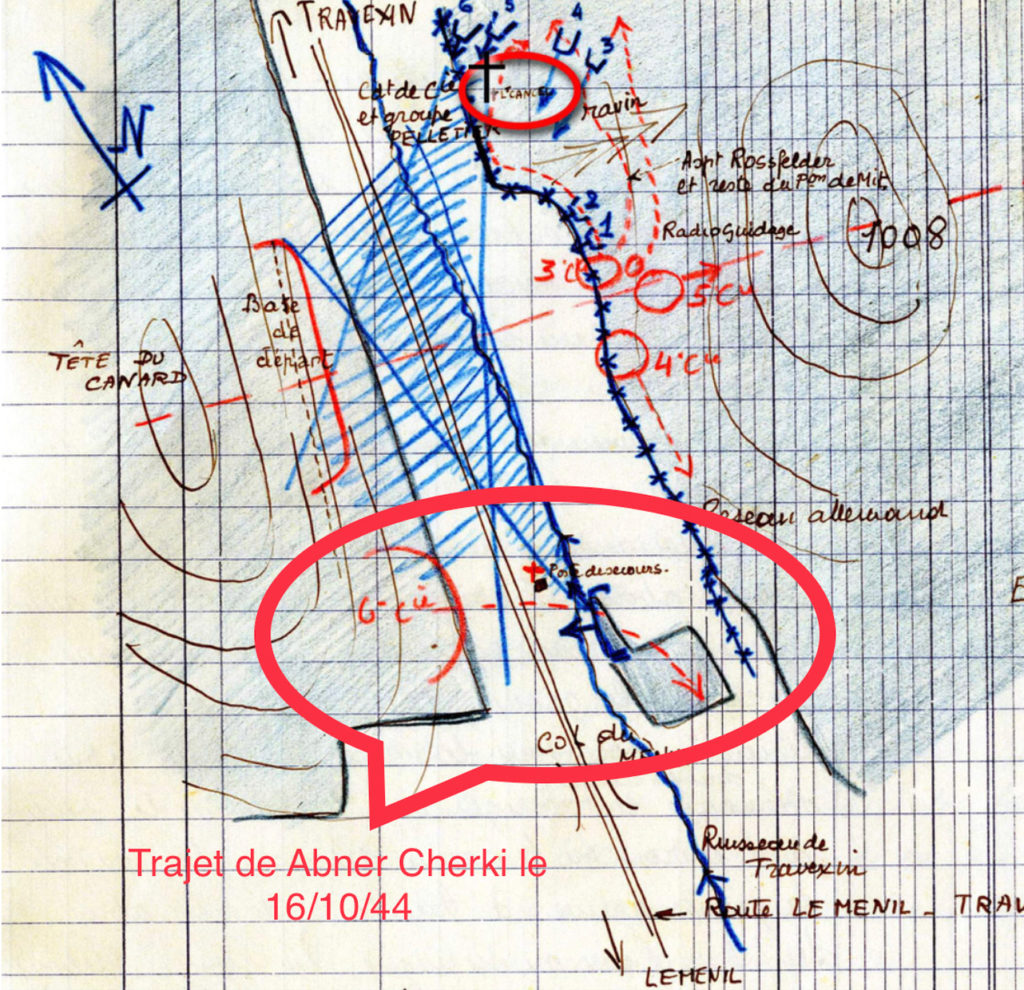
Robert Wagener’s history of the 1st RCP for the day of October 16, 1944, also reads:
“…in the pouring rain, the offensive got under way…many men, mowed down in their rush, remained on the ground, while the doctors, nurses and chaplain Mulson devoted themselves to the stricken paratroopers, demonstrating great courage under the deadly German fire…”.
He takes part in the Alsace campaign, from December 10 to 16, 1944.
He took part in the Rhine guard on December 10, 1944 (Gerstheim to be verified), in the fighting at Witternheim on December 13, 1944 and at Neunkirch on December 14, 1944.
On December 14, the 6th Company led a diversionary attack to the west of Witternheim, eventually taking the village on its own, as the 1st Battalion had been caught in a deluge of artillery fire that decimated it. The town of Neunkirch was defended two days later against fresh German troop assaults, but these were repulsed at the cost of heavy losses for the 1st Battalion.
Medically evacuated on December 16, 1944, transferred to B.R2 on the same day.
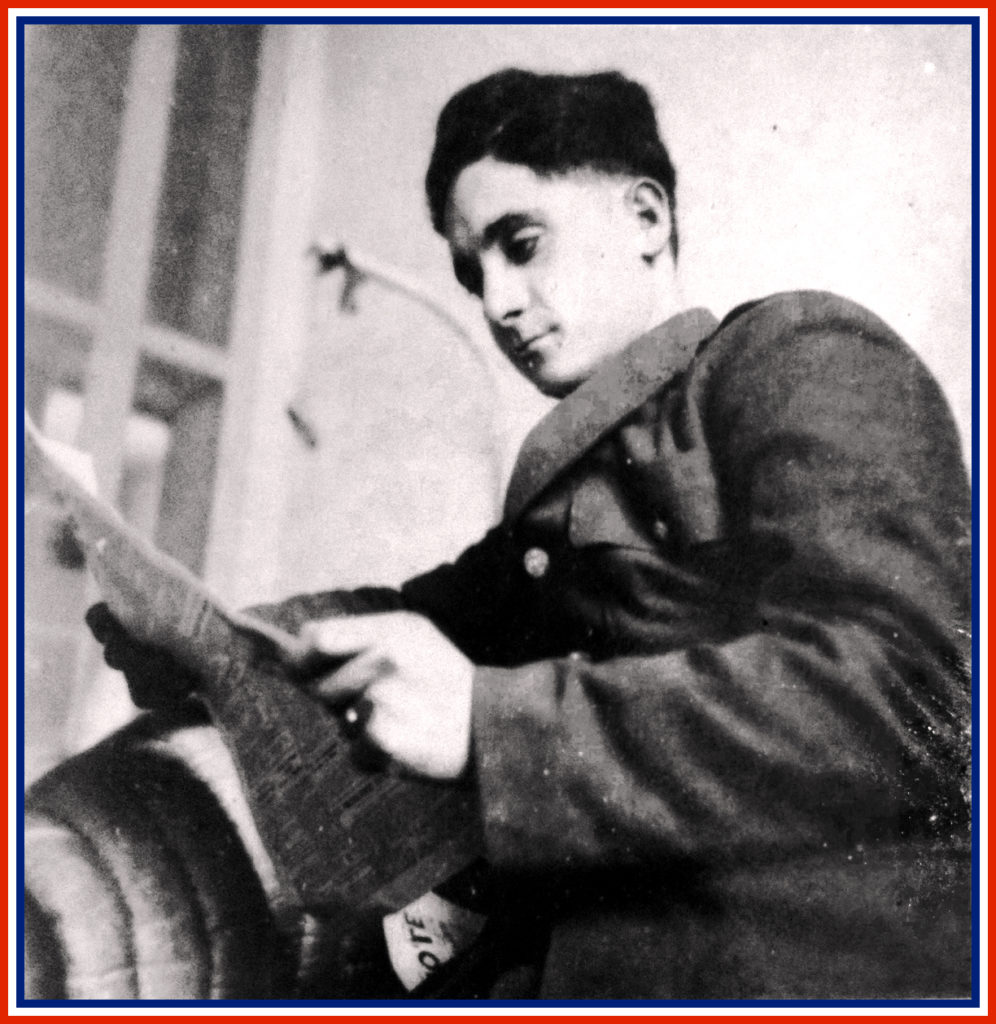
He joined the 1er RCP depot in Lons-le-Saunier on January 31, 1945, where he was reassigned to the 6th company on February 20, 1945.
On March 12, 1945, Lieutenant-Colonel FAURE, commander of the 1er RCP, promoted him to the rank of 1st class soldier.
In a letter written on June 24, 1945 to his friend Lison, Abner tells her a funny story: “On Victory Day (most likely May 8) we had 36 hours’ leave, but I thought it was too short, so I took another 72 hours…the result: 15 days in prison!”
Abner Cherki told his grandson Noam that, at the Liberation, to take part in the Victory Day parade on July 14, 1945, there were frequent stops at several stations before arriving in Paris…everyone was very happy when they got off the train!
He was due to jump on July 14 with the1st RCP at Longchamps, but bad weather forced the cancellation of the operation, much to the regret of Abner and his comrades.
He took a leave of absence in the capital before his demobilization, and stayed at the Hotel Lutetia, headquarters of the Abwehr (intelligence service) during the German occupation.
In Paris, he met the future King of Morocco, Hassan 2: the meeting took place at a funfair in bumper cars…and His Majesty’s bodyguards didn’t take too kindly to it.

He was demobilized on October 5, 1945 by the Blida demobilization center.
According to Abner, his return to Algeria was by plane, in the bomb compartment, with the hatch open and his legs stretched out over the void.
his decorations :
Cross of War 1939-1945 with Bronze Star.
Medal for war wounded.
French War 1939-45 Commemorative Medal with “Libération” bar.
Italian Campaign Commemorative Medal.
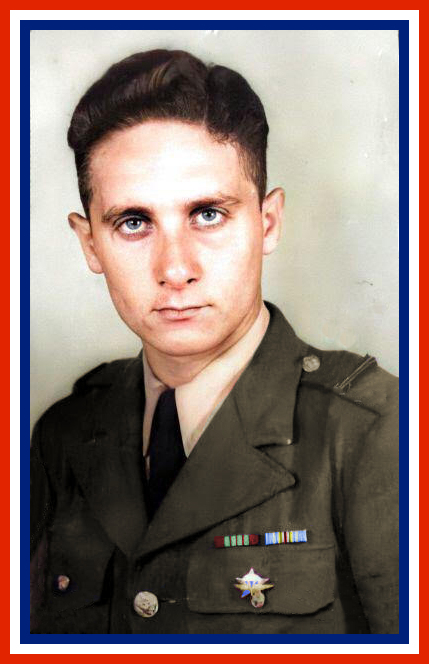

Abner and Marcelle left Algeria for good in 1959.
Initially living in Paris, Abner Cherki passed the entrance exam for EDF-GDF, where he made his career.
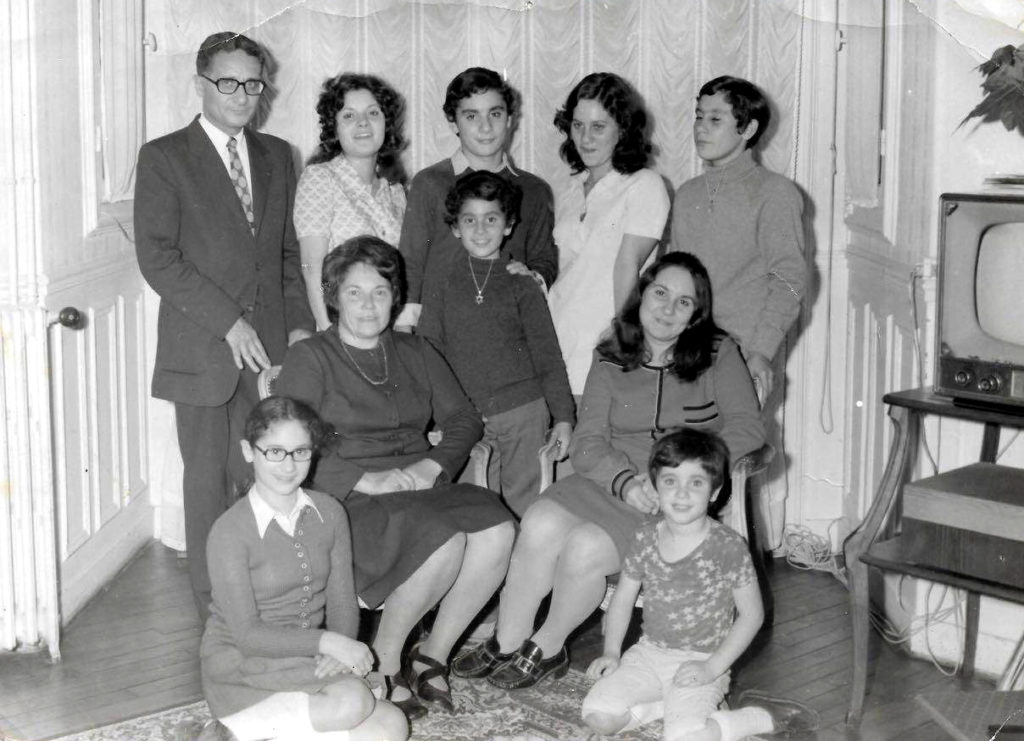
Through promotions and competitions, they moved to Nevers, Enghien-les-Bains, Nancy and finally Pontoise, where he retired as Head of Personnel.
In 1989, they fulfilled their dream of immigrating to Israel while continuing to live French-style.
They had 9 children,

36 grandchildren and over 60 great-grandchildren. Marcelle is now a great-great-grandmother.
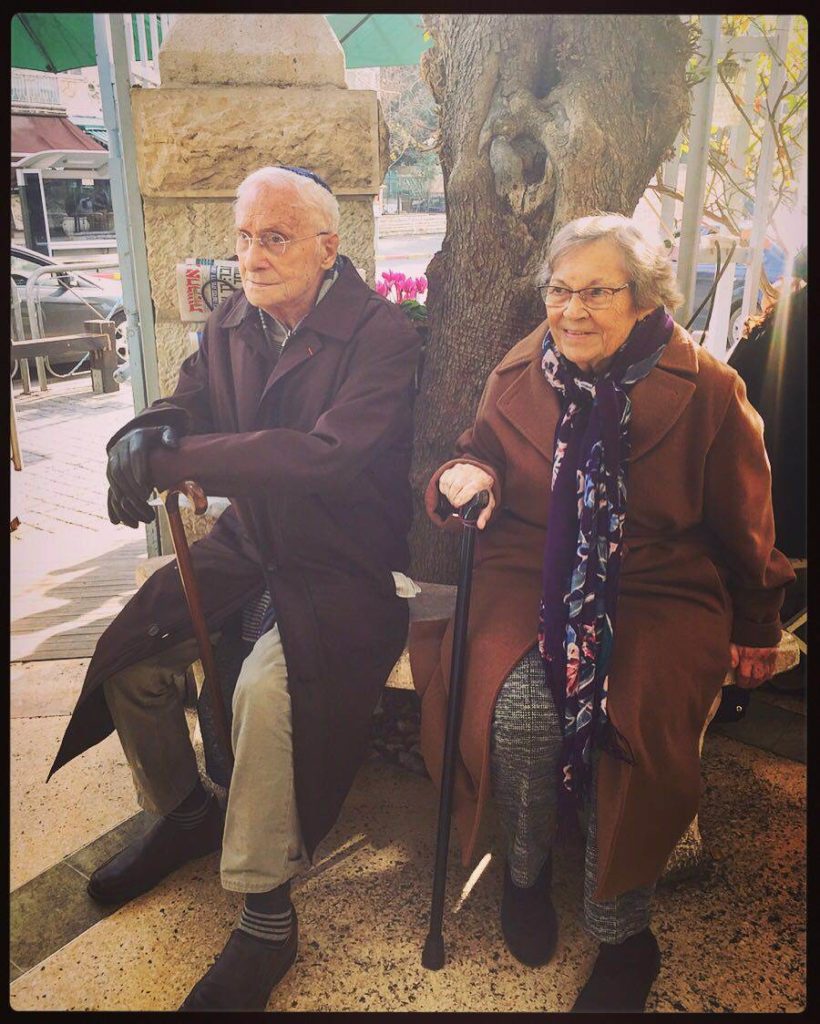

He died on December 12, 2020 in Jerusalem, a week before his 96th birthday.
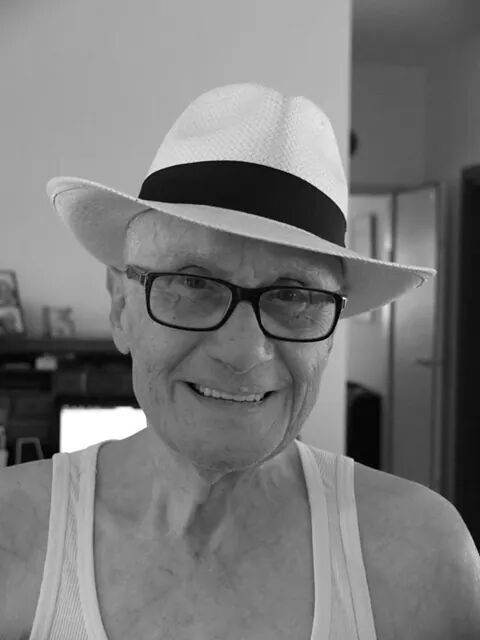
Thank you Monsieur CHERKI for your commitment to the service of France…we won’t forget you!
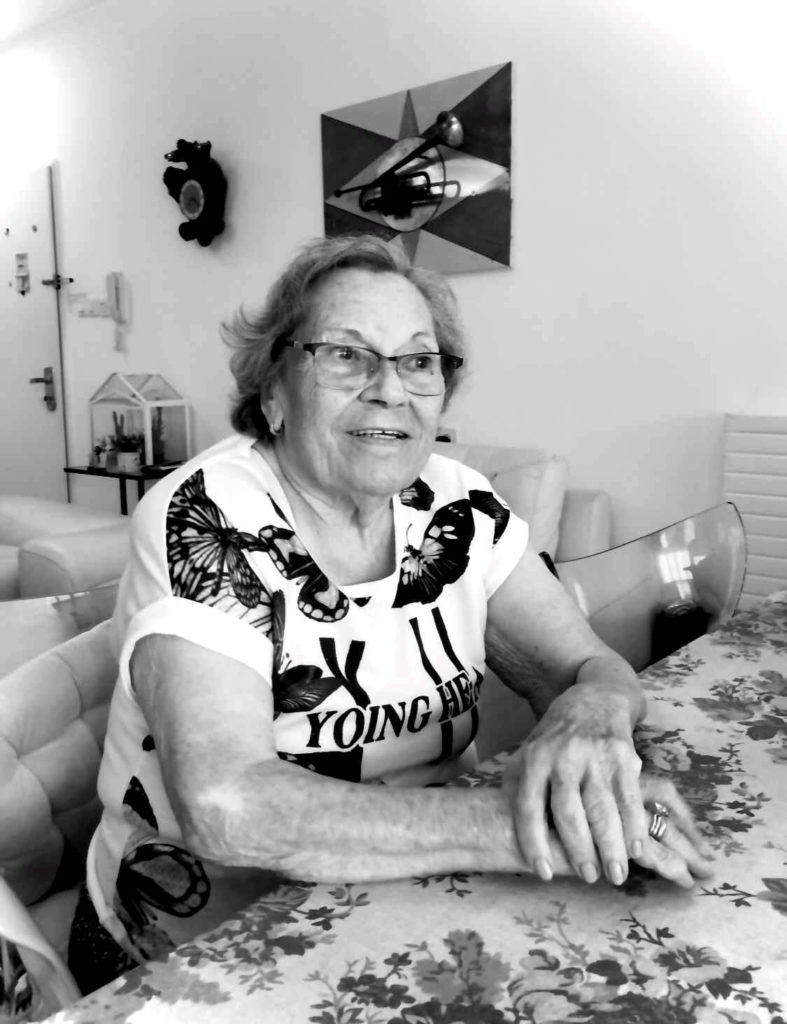
His dear and loving wife Marcelle née Sourgne (1929-2024) joins her “Loup coquet” for eternity on Tuesday May 7, 2024, and they will remain forever in our hearts.
Our warmest thanks go to: Noam Assouline, with whom we wrote his grandfather’s story, and his family for sharing the family archives – Monsieur Level Président de l’Amicale du 1er RCP – Guillaume Morelli and David Raffetin for their expertise and invaluable help. sources: ASSOULINE-CHERKI family – national archives – internet – Musée de la résistance en ligne – Robert Wagener’s history.
additional information:
US M3 PAL (for Pal Blade Co.) dagger by Abner CHERKI with its personalized scabbard featuring its “totem” …Loupcoquet.

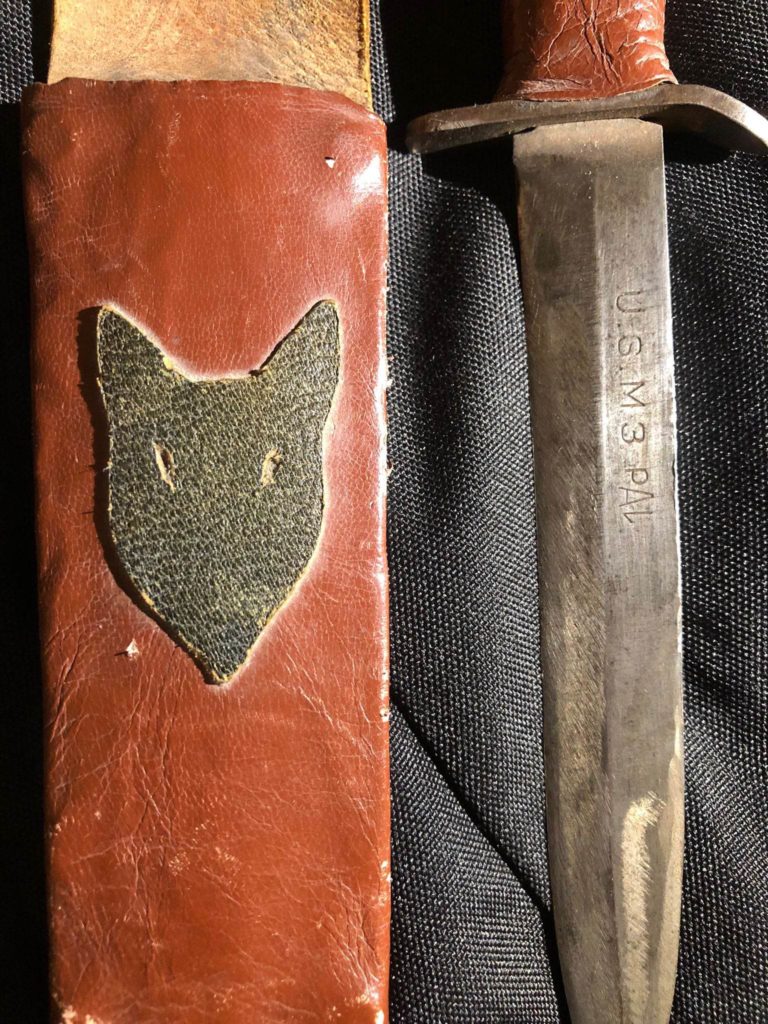

“The Little Sea Horse “… 36th Engineer Combat Regiment.
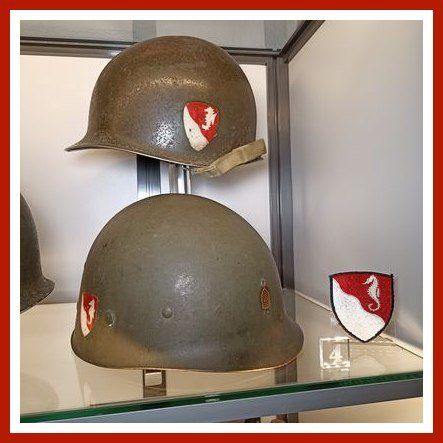
US M1 helmet, liner and fabric badge from the 36th Engineer Combat Regiment, an American combat engineer unit trained for amphibious assault and support operations. This unit is credited with the highest number of amphibious assaults (5) during the Second World War (TORCH – SICILE – NAPLES – ANZIO – DRAGOON). It supported Allied units in the Alsace, Ardennes, Rhineland and Central European campaigns.
History:
The 36th Engineer Combat Regiment was formed in October 1933 and activated on June 1, 1941 at Plattsburgh Barracks, New York.
At 5 a.m. on November 8, 1942, the regiment took part in Operation Torch, landing at Fedala in Morocco.
After spending eight months in North Africa, the Regiment set off for Sicily on July 7, 1943, and three days later set foot on Sicilian soil… the start of Operation Husky.
On September 10, 1943, they set foot on Italian soil at Salerno… the start of a journey lasting almost a year, beginning with the famous battles of Anzio, Cisterna and Rome.
The 36th Engineer’s next destination…France!
On August 15, 1944, after Operation Dragoon, the regiment moved up the Rhône valley, reaching Besançon on September 11, 1944.
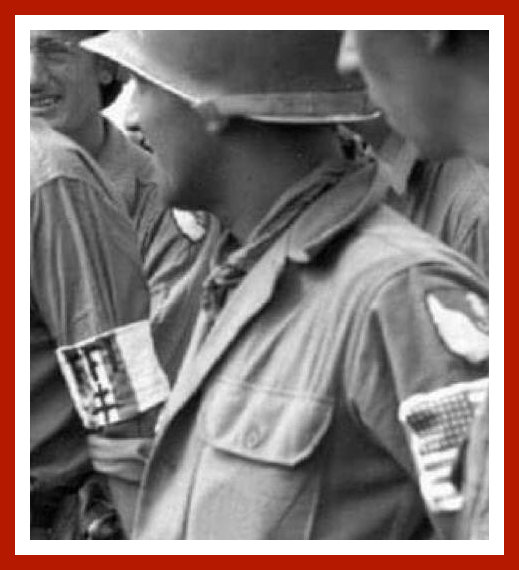
From October to the end of November 1944, the Regiment was in the Vosges. On November 29, it was split in two.
On one side, the 2nd and 3rd Battalions headed for northern Alsace via the Col de Saales; on the other, the 1st Battalion (1/36th Engineer) bivouacked in the Saint Marie aux Mines sector.
In the early days of December 1944, the 1/36th Engineer became a support unit for the 36th Infantry Division. At that time, it was in the Sélestat – Ribeauvillé sector.
From December 8 to 9, the battalion was officially attached to the 36th Infantry Division, which in turn was attached to the 1st French Army.
Until December 13, 1944, the regiment’s command post was in Sélestat, but the “Seahorses” were in the field, in the Riquewihr-Ribeauvillé-Bergheim sector, with the task of maintaining the roads and numerous bridges in the area. From December 13, Ursprung above Riquewihr became the new bivouac area for the men of the 1st Battalion for a few days.
December 14 marked the end of the extremely trying Operation Habicht (German counter-attack from December 12 to 14, 1944, aimed at recapturing Sélestat and the Sigolsheim-Riquewihr-Ribeauvillé sector to “wipe out” the US 36th Infantry Division). The shortage of men was such that Company B and C each became conventional infantry combat units, as did the 111th Engineer Battalion of the 36th Division. Only Company A of the 36th Engineer remained in reserve in the Ribeauvillé sector. Company B was attached to the 142nd Infantry Regiment (36th Infantry Division) and Company C to the 36th Reconnaissance Squadron (36th Infantry Division). The arrival of the 30th Infantry Regiment of the 3rd Infantry Division will unblock the situation in this sector.
The men of the 36th Engineer moved into the Alspach (Kaysersberg) sector on December 17, where clashes were particularly fierce between the “Marnemen” of the 30th Infantry Regiment (3rd Division), the Texans of the 141st Infantry Regiment (36th Division), Combat Command 4 and 5 and the German army.
During these two days, Company C supported the French troops on the right flank of the 30th Infantry Regiment, while Company B cleared sections of road higher up the valley between Kaysersberg and Fréland.
On December 19, after the liberation of Kaysersberg and Ammerschwihr, the 1/Battalion of the 36th Engineer Combat Regiment headed for northern Alsace to join up with the rest of the regiment.
During their journey through the fighting in the Colmar pocket, the 1st Battalion suffered no casualties, but the “HS” Company (Headquarter and Service) had 3 killed.
Until the end of December, the Regiment was stationed in the Kutzenhausen/Hatten sector. From January 1 to March 23, 1945, the 36th Engineer was heavily involved in Operation Nordwind, moving between Lembach, Phalsbourg, Raon l’Etape and Wissembourg. Arriving in Germany at the end of March 1945, the Regiment headed for Bavaria. Part of the Regiment was in Austria, while the other was in the Garmisch Partenkirchen sector at VE Day (Victory in Europe Day).
Throughout the conflict, the 36th Engineer Combat Regiment built countless infrastructures (bridges, roads…), making the task easier for numerous Allied units and divisions, each more prestigious than the last.
Stay Rugged!
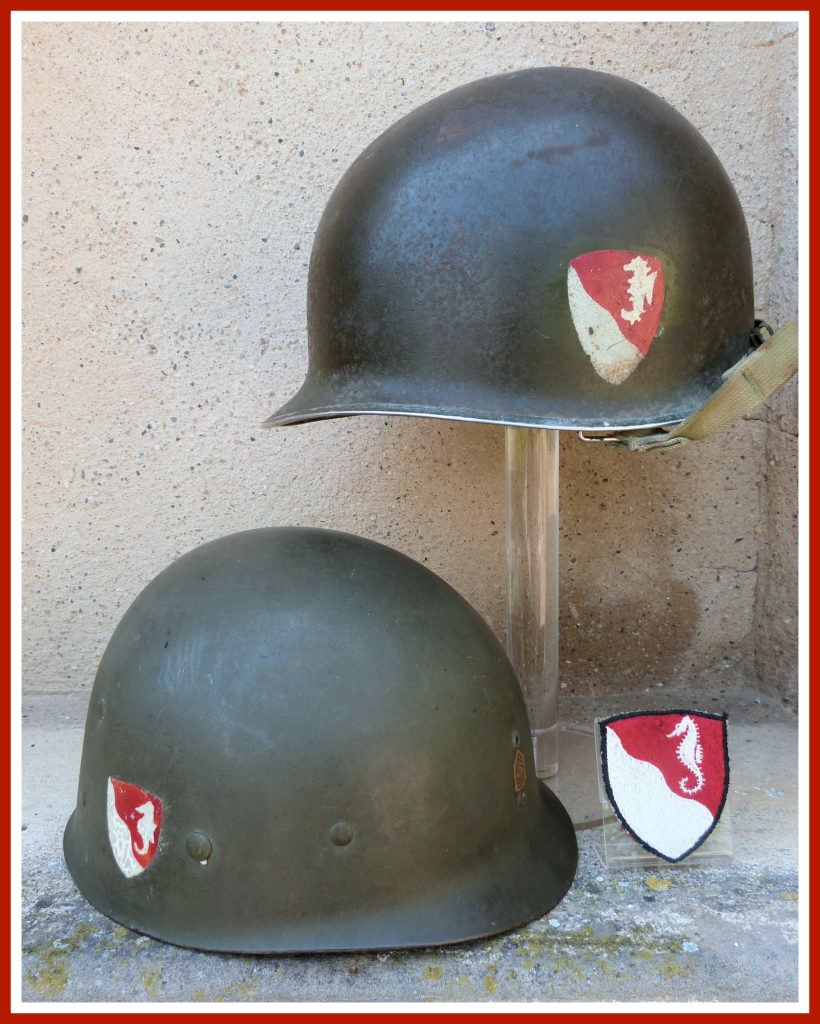
Lucien MAURER 1924 – 1991

From Wehrnummer 24/122/1/8, through 81G-258213, to service number 4468003839…
Lucien Maurer was born on March 28, 1924 into a farming family in Niederhergheim (68).
He attended the local school until the age of 14, obtaining his school-leaving certificate on July 6, 1938.
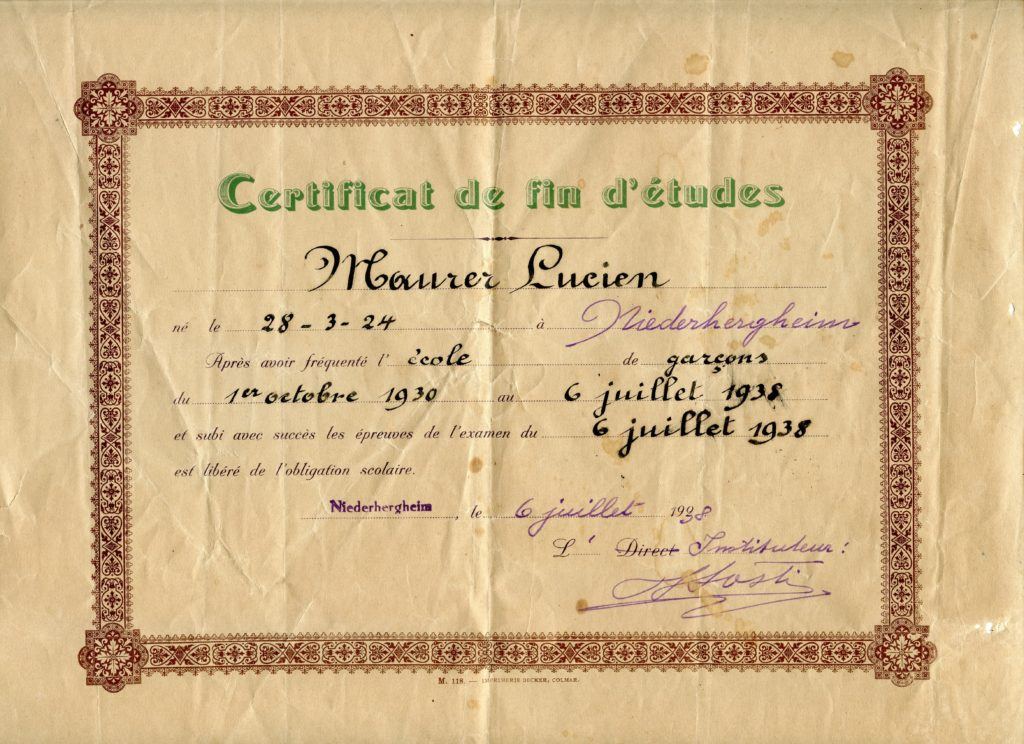
In January 1942, he began an apprenticeship to become a carpenter, but this was interrupted from April 19 to September 25, 1942, when he had to join the ReichArbeitDienst (RAD – Reich Compulsory Labor Service) like all Alsatians and Moselle residents his age.
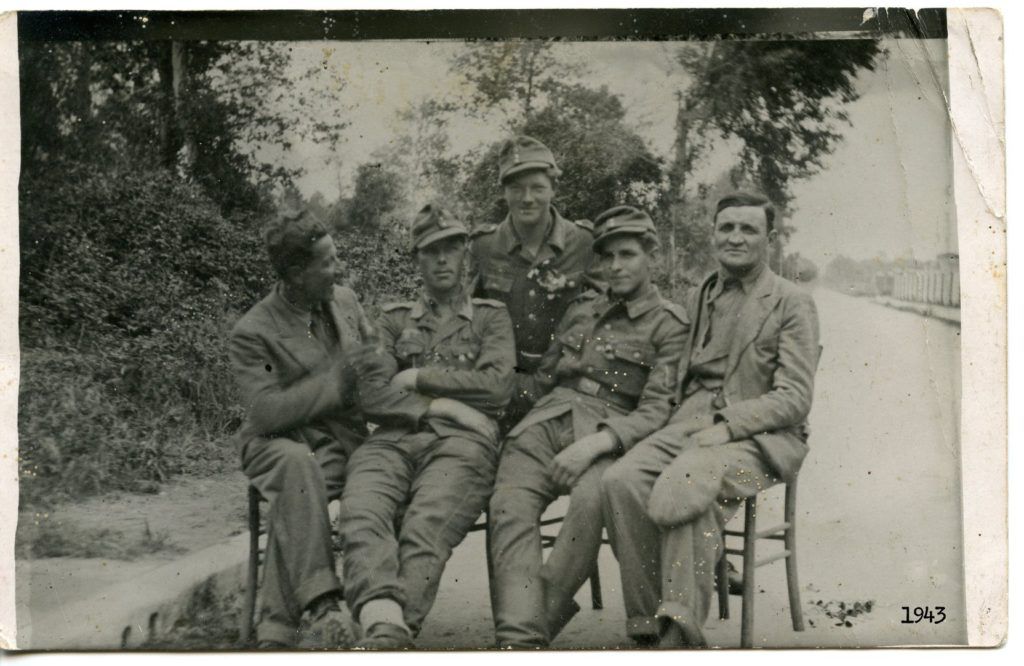
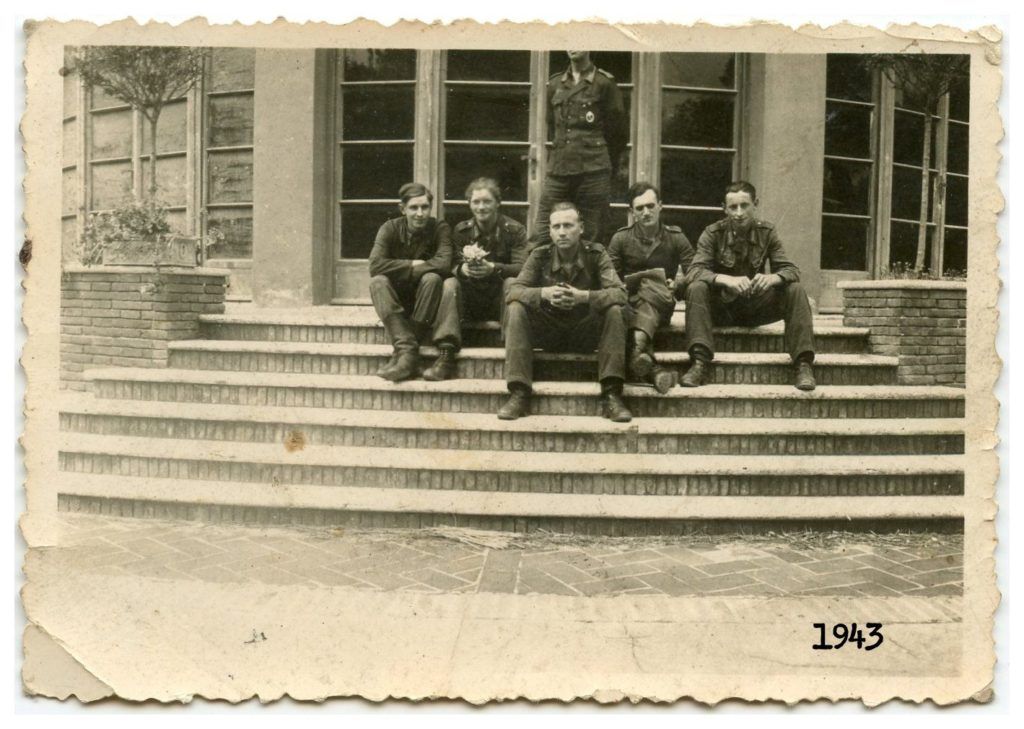
On his return, he was reunited with his apprenticeship master until he was drafted into the German army on January 16, 1943 (his older brother Joseph, born in 1922, was also incorporeted forced 2 days earlier, on January 14, 1943, but did not return; he was killed in Poland on August 23, 1944).
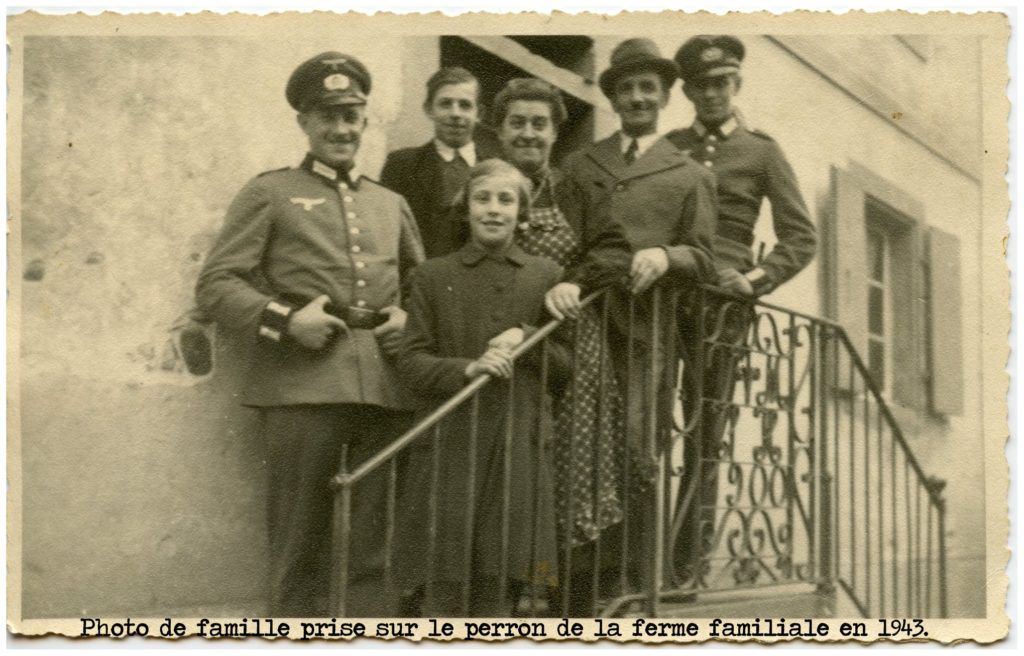
Before their departure, all the men of the Niederhergheim class of 1924 took a few souvenir photos on the station platform. As in the rest of Alsace… unfortunately, not all of them will return…
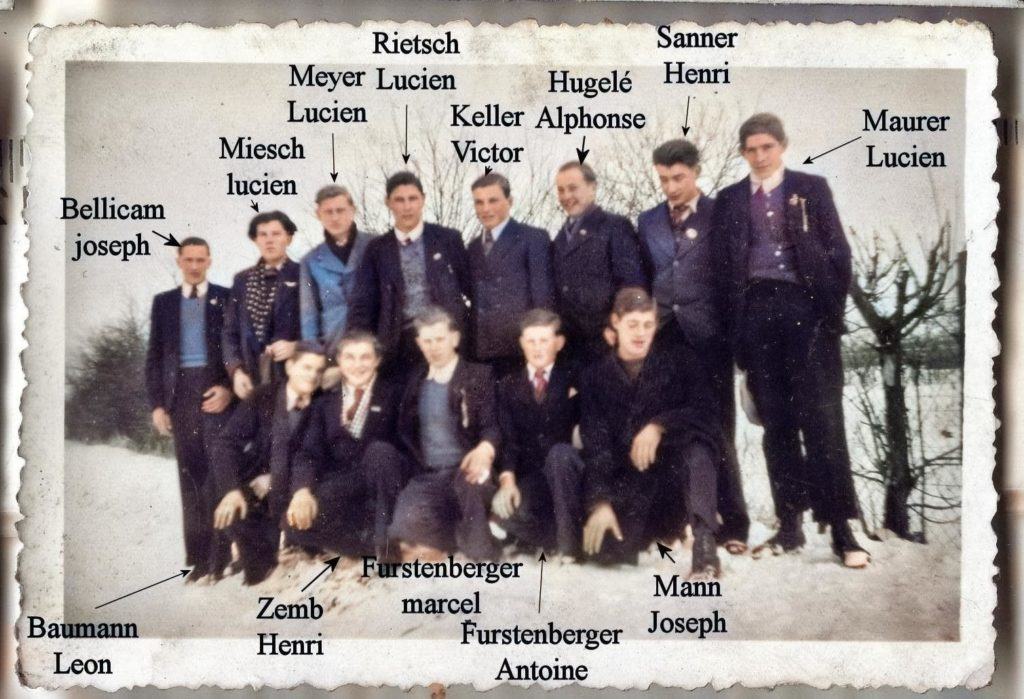
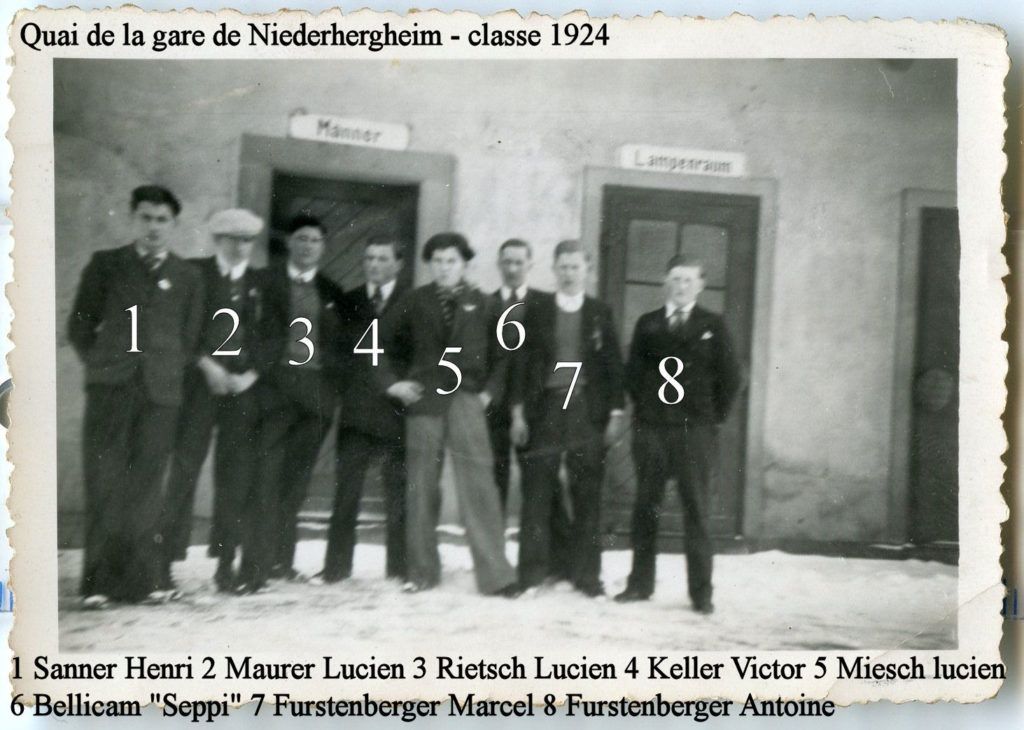
On January 18, 1943, Lucien began his Grenadier training with the 3 Kompagnie/Grenadier-Ausbildungs- Battaillon 213 in Laun. On June 10, 1943, he joined the Marsch-Kompanie/Grenadier-Ersatz- Battaillon 213 before being assigned to the 9.Kompanie/Grenadier-Regiment 314. With which he fought in Yugoslavia and Italy.
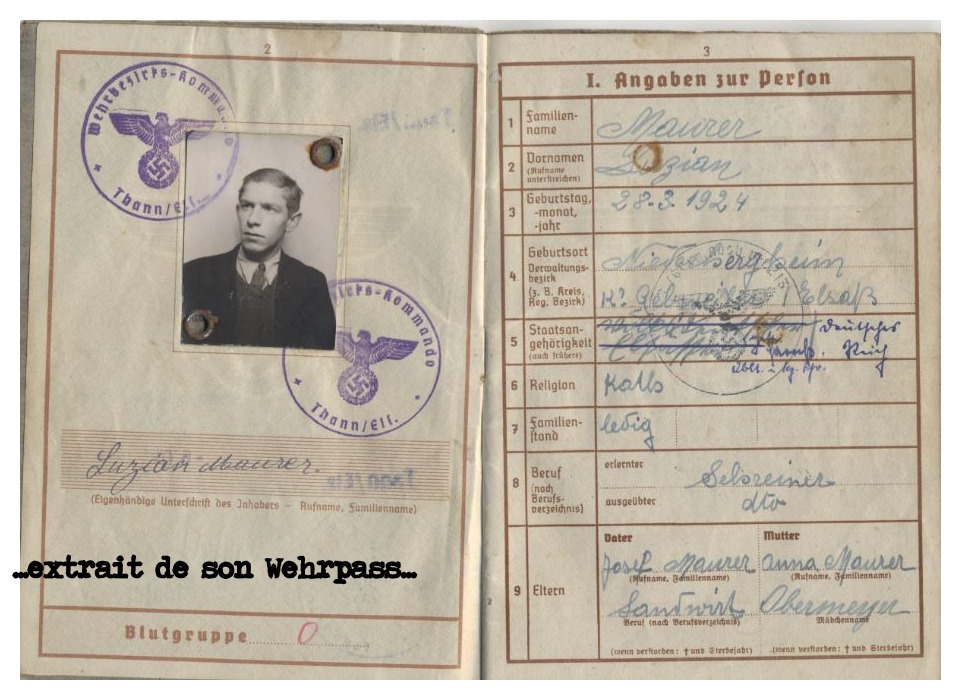
It was near Grosseto, Italy, that he surrendered to the Americans on June 17, 1944, deserting his post while on guard duty, under the cover of darkness.
Taken prisoner, interned in the P/W Camp n°326 (to be located) under number 81G-258213, he was handed over to the French authorities on June 25, 1944, after undergoing several interrogations to ensure that he was indeed an Alsatian incorpored forced (the Allies were well aware of the fate of the Alsatians-Mosellans).
On June 26, he was assigned to the 901/S beach base command company.
He embarked at Naples on September 6, 1944 and landed at Saint-Tropez on September 9, 1944.
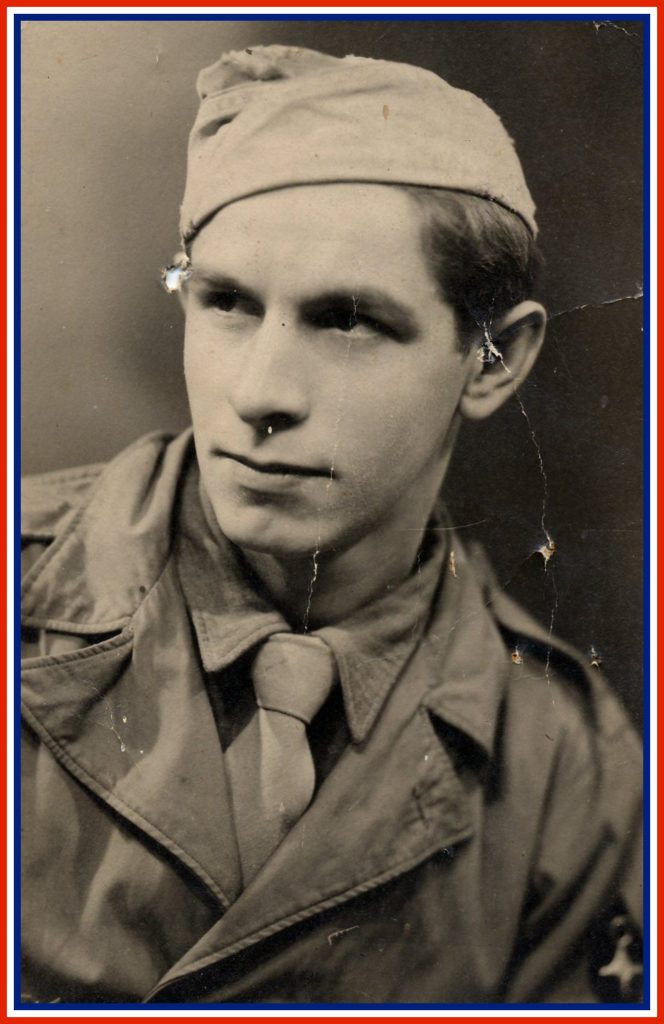
Within the 1st French Army, he joined the 211th Heavy Bridge Battalion and was assigned to the 2nd Company. On November 1, he was appointed 1st class.

As his home village was liberated on February 5, 1945, he made his first “surprise” visit at lunchtime – after long months of uncertainty and waiting for his parents – on February 8 from Mulhouse, where his unit was rebuilding a bridge. He made the round trip during the day with his crane and the authorization of his superior. He made a 2nd visit 8 days later, spending the night at home with his crane parked in the village streets. A moment immortalized by 2 photos with his parents, brother and sister.
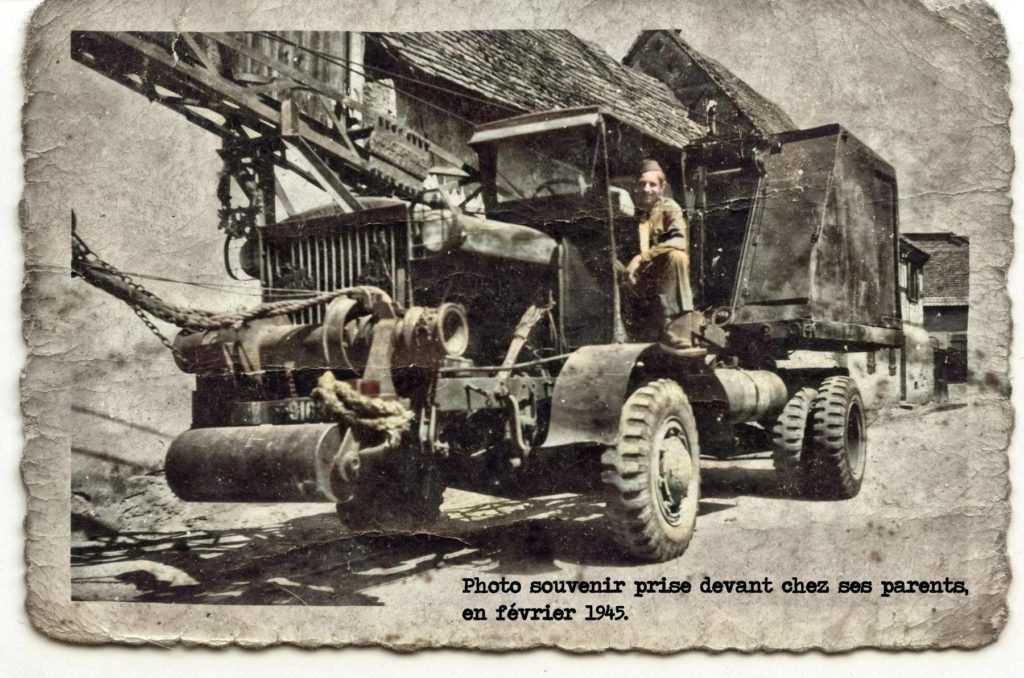
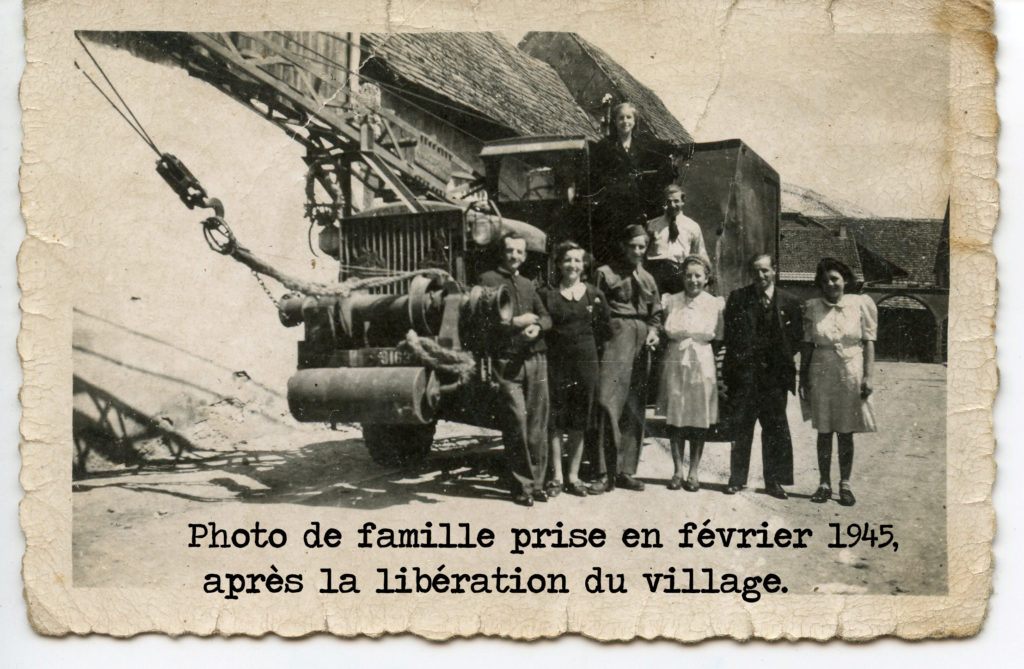
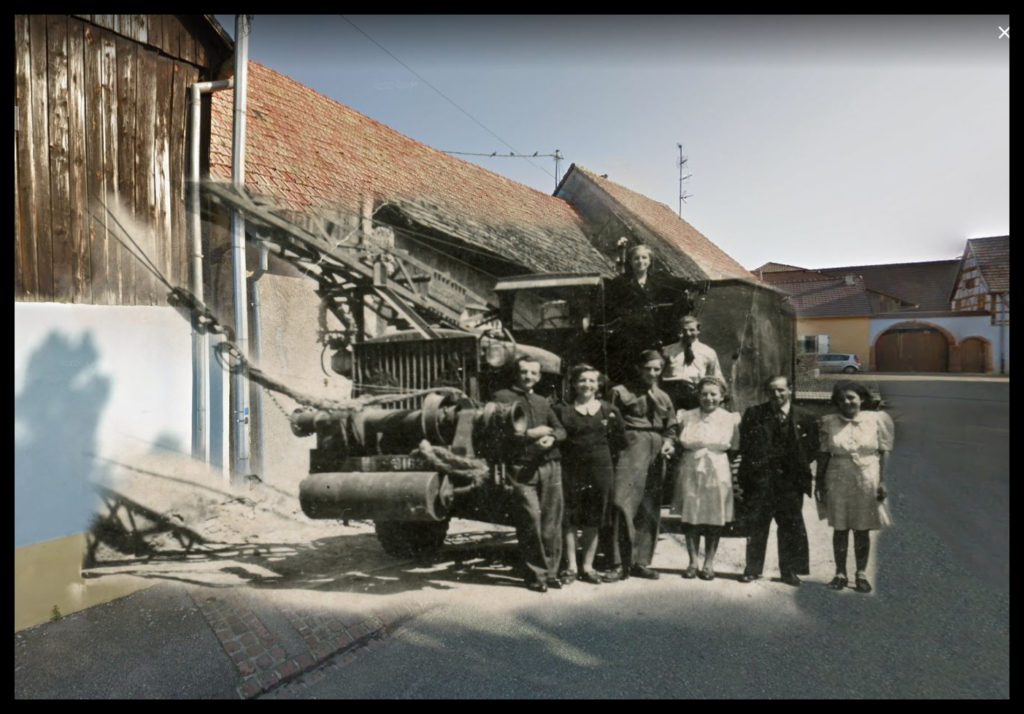
His younger brother (born in 1927) narrowly escaped being incorporeted forced, hiding on a snow-covered roof when the Germans were looking for him following a denunciation.
Lucien received a citation in the regimental order for his action on April 2, 1945 at Leimersheim (Germany): “The driver stood out for his cold-bloodedness in ensuring the unloading of bridging material on the bank of the Rhine, which was then under heavy enemy artillery fire”.
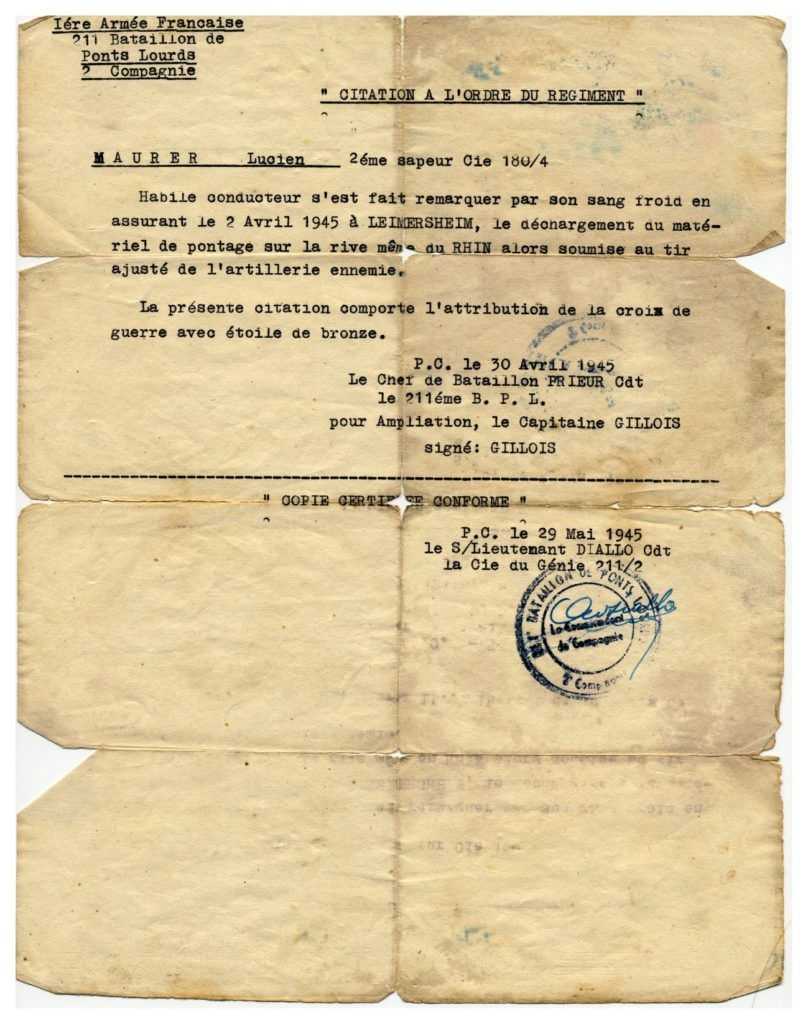
In a notebook found after his death, on one of the pages he had noted the towns he had passed through, and had titled it “Journey in the 1st French Army” : Naples – Rome – Sienne – Pagiponsi –Sienne – Civitavechia – Rome – Théano – Naples – Baginioli – Saint-Tropès – Aix – Valence – Geriol – Givors – Bourg – Besançon – Clerval – Montbéliard – Sochaux – Audincourt – Colombier – Fontaine – Mulhouse – Sochaux – Clerval – Sochaux – Dornach – Obernai – Strasbourg – Seltz(67) – Bellheim(all) – Seltz(67) – Gingenfeld(all) – Bellheim(all) – Gemersheim – Bellheim(all) – Gemersheim(all) – Bellheim(all) – Maximiliamsau(all) – Gemersheim(all) – Maximiliansau(all) – Germensheim(all) – Maximiliansau(all).
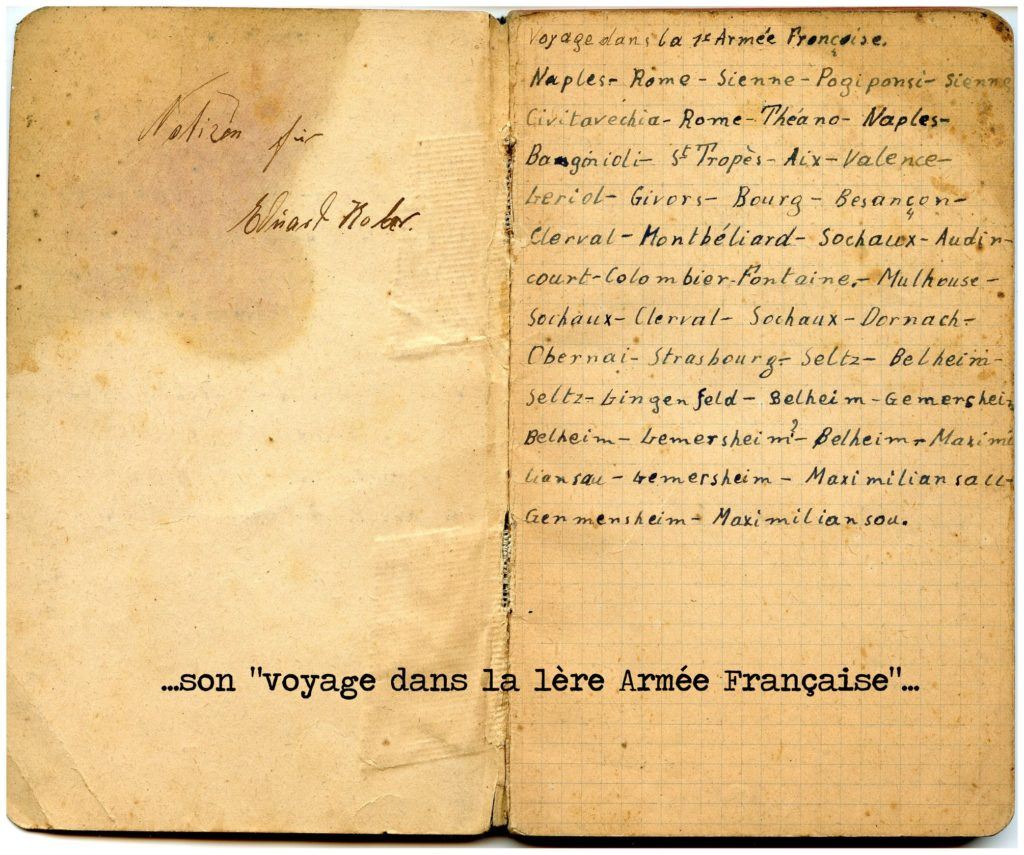
He was demobilized from the active army on August 1, 1945.
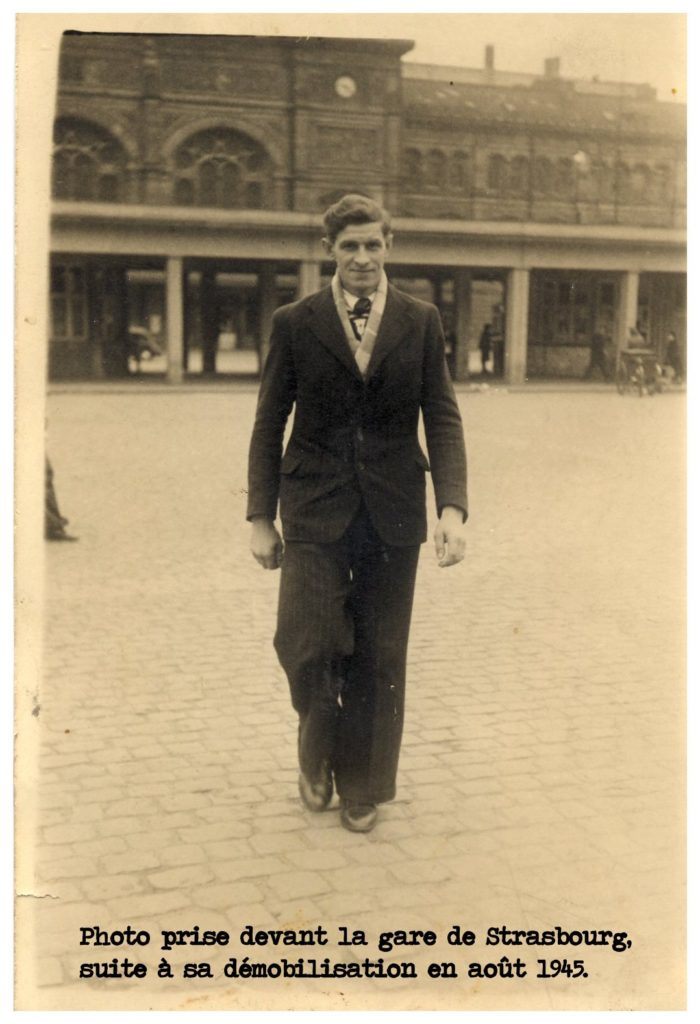
On his return, he finished his apprenticeship as a carpenter, a trade he practiced throughout his life, in the midst of a large family, which he sadly “left” too soon in 1991.
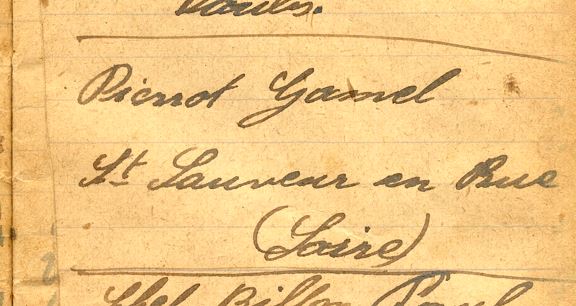
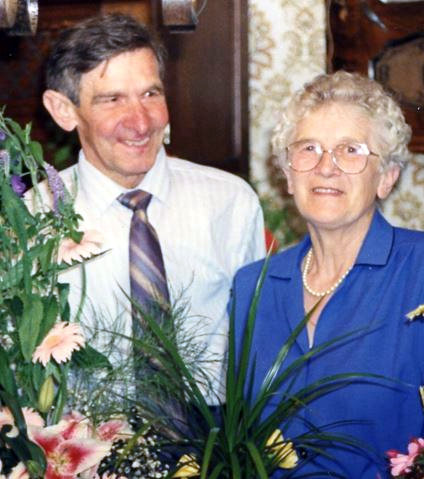
This publication is in memory of my grandfather, his comrades, the draftees from Alsace and Moselle (and their families), the malgré-elles, who, like him, had to fight under a uniform they hadn’t chosen, for an ideology that wasn’t theirs, and who got on with their lives as best they could after so much suffering that will stay with them forever. For his part, he will hardly ever talk about it, out of “shame” at having had to fight under German uniform, and above all out of aversion to war and its ravages. Let us never forget the sacrifices of this generation and these tragic events, so that it never happens again. Laurent K.
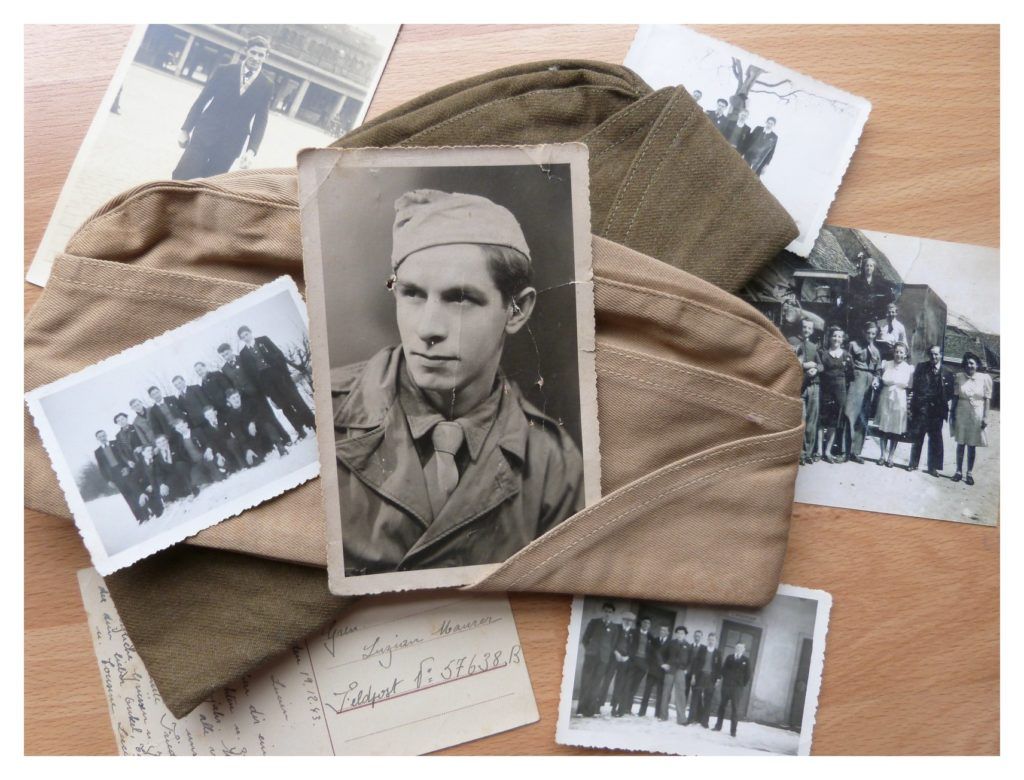
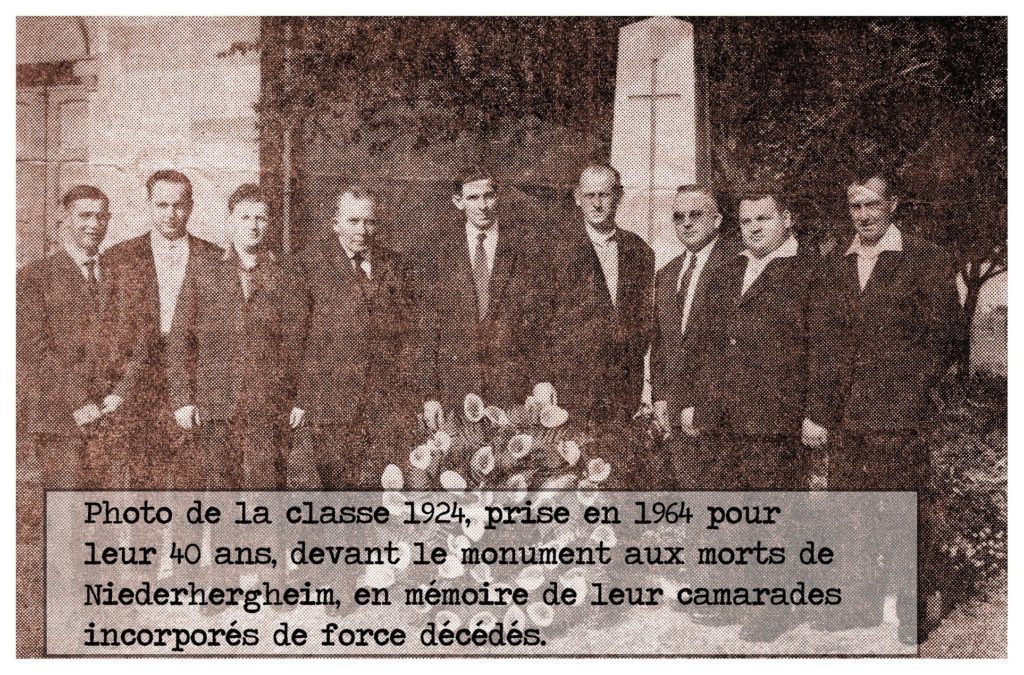
Source documentaire et photo : famille Maurer.
Panzer V Ausf. G “Panther” n° 420, Panzerbrigade 106 “Feldherrnhalle”
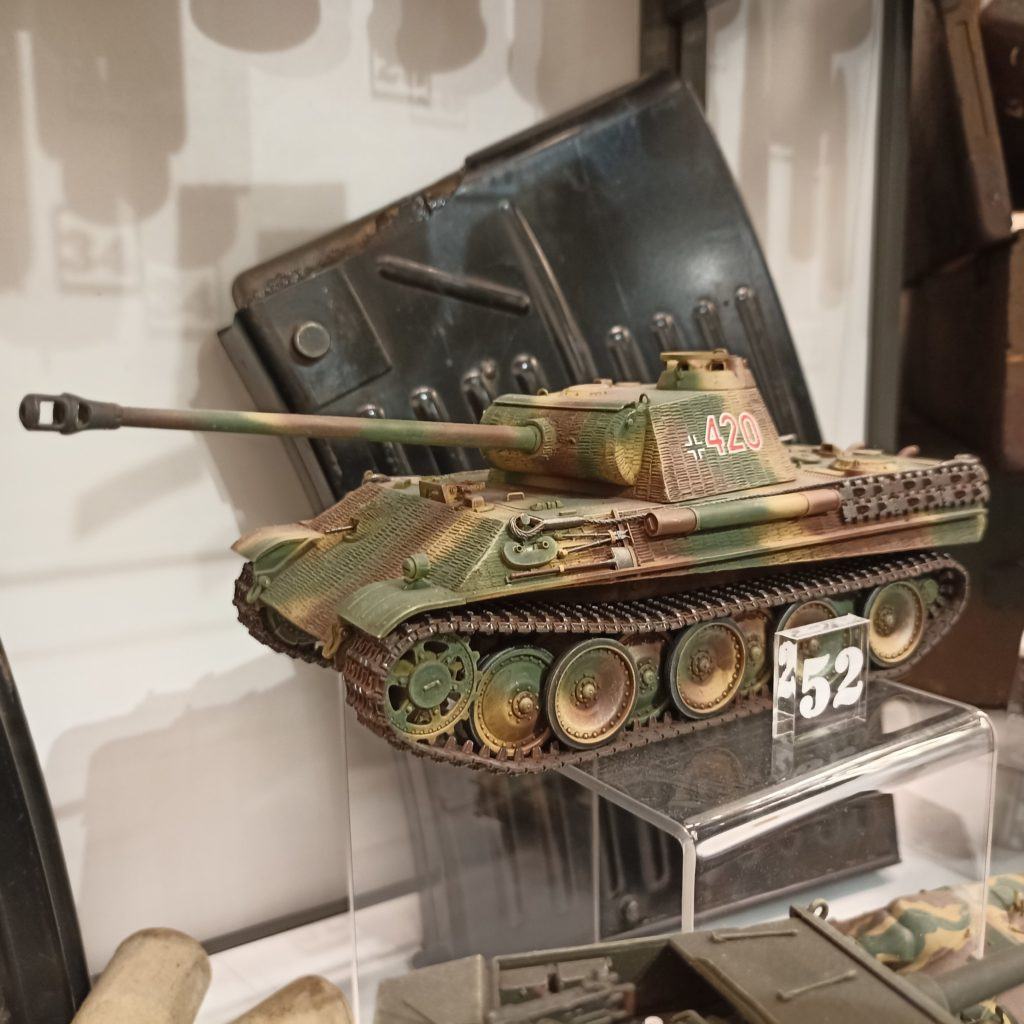
Panzer V Ausf. G “Panther” of Panzerbrigade 106 “Feldherrnhalle” destroyed at “la Place” (commune of Labaroche) on 22 December 1944 by Sherman M4A4 “Leopard” n°27 and “Laon” n°24 tanks of the 2nd squadron of 1er Cuir.
Before being hit by the French tanks, it had itself destroyed the Sherman M4A4 tank “L’Aspic II” of the 1er Cuir.
For the record, the crew of the German tank was found, by chance, in a cellar of the village by the men of the 1st Algerian Rifle Regiment (1er RTA) sent on reconnaissance, and who following a “deluge” of German artillery had also taken refuge there.
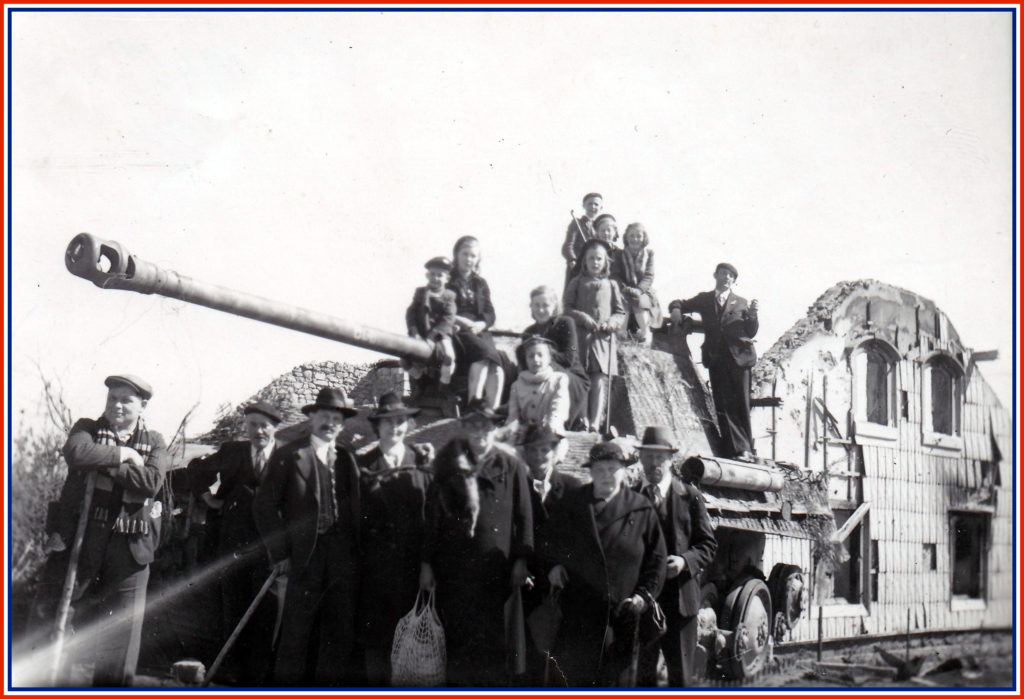
Souvenir photos taken after the war at the very place where it was destroyed on 22/12/1944 – private collection.
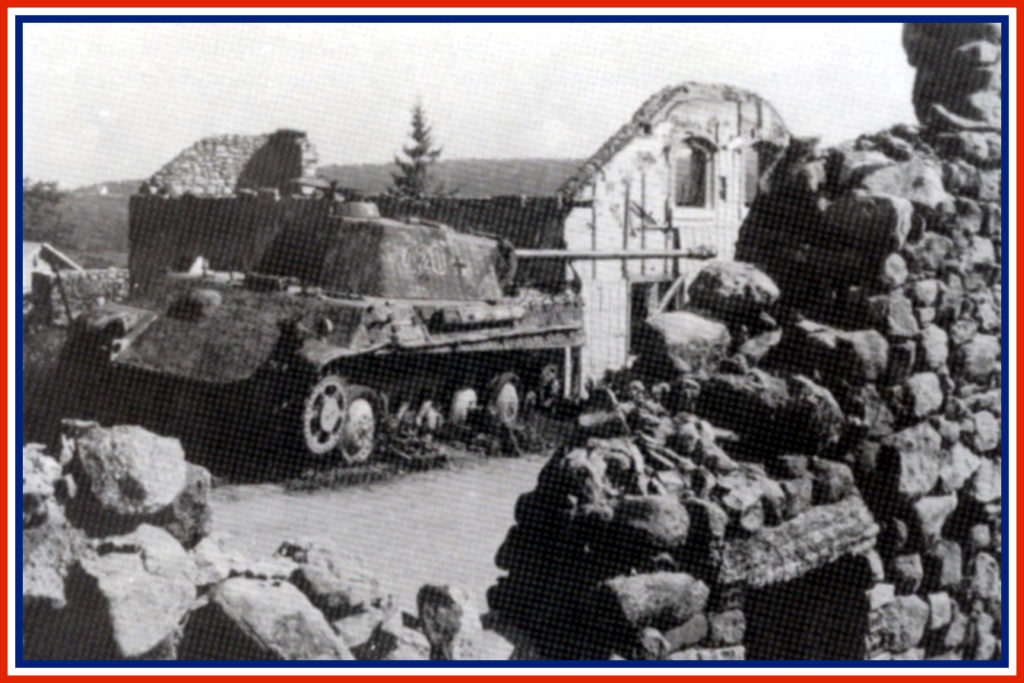
Main features:
Manufacture to 2950 specimens.
Armament : KwK 42 75 mm gun (82 shells) and 2 MG 34 7,92 mm machine guns (4200 rounds).
Crew of 5 men (tank commander, pilot, radio gunner, gunner and loader).
Length 8,86 m (with gun) or 6,87 m (without gun).
Width of 3.42 m and height of 3.1 m.
Weight: 45 tons.
Engine : Maybach HL 230 P30(700hp) – consumption 3 liters per kilometer.
sources : “50th anniversary of the Liberation of Labaroche” – french chars website – private collection – internet.
Pilote de P-47 Thunderbolt
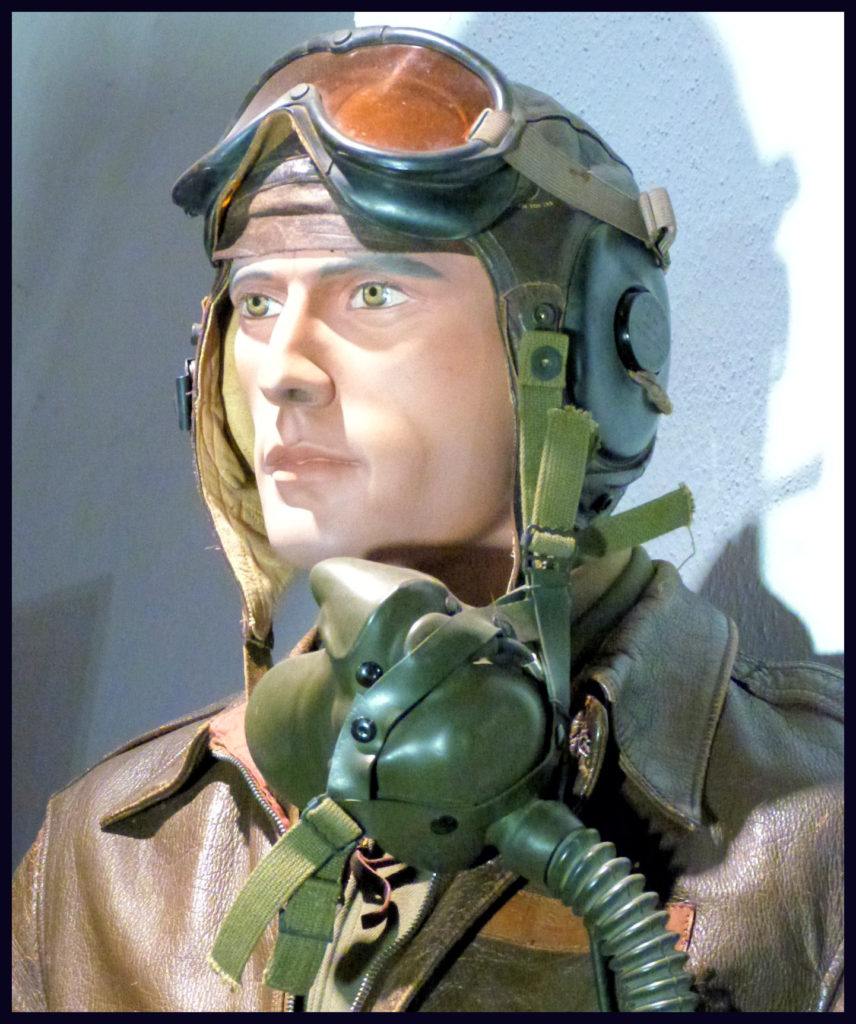
P-47 Thunderbolt pilot with his complete equipment.
He is wearing an A-11 flight cap with radio headset and an A-14 oxygen mask.
In his left hand he is holding his AN-6510 seat parachute with its harness.
He is also wearing a leather “Flight-Jacket” A-2 and a flight suit type AN-6550.
This AN-6550 flight suit is the one worn by Roger Guillaume (photo below), a pilot with the GC 2/5 “Lafayette” who was shot down by German flak on 20/11/1944 during a strafing mission (ground attack) where he was strafing a train in Colmar station (68).
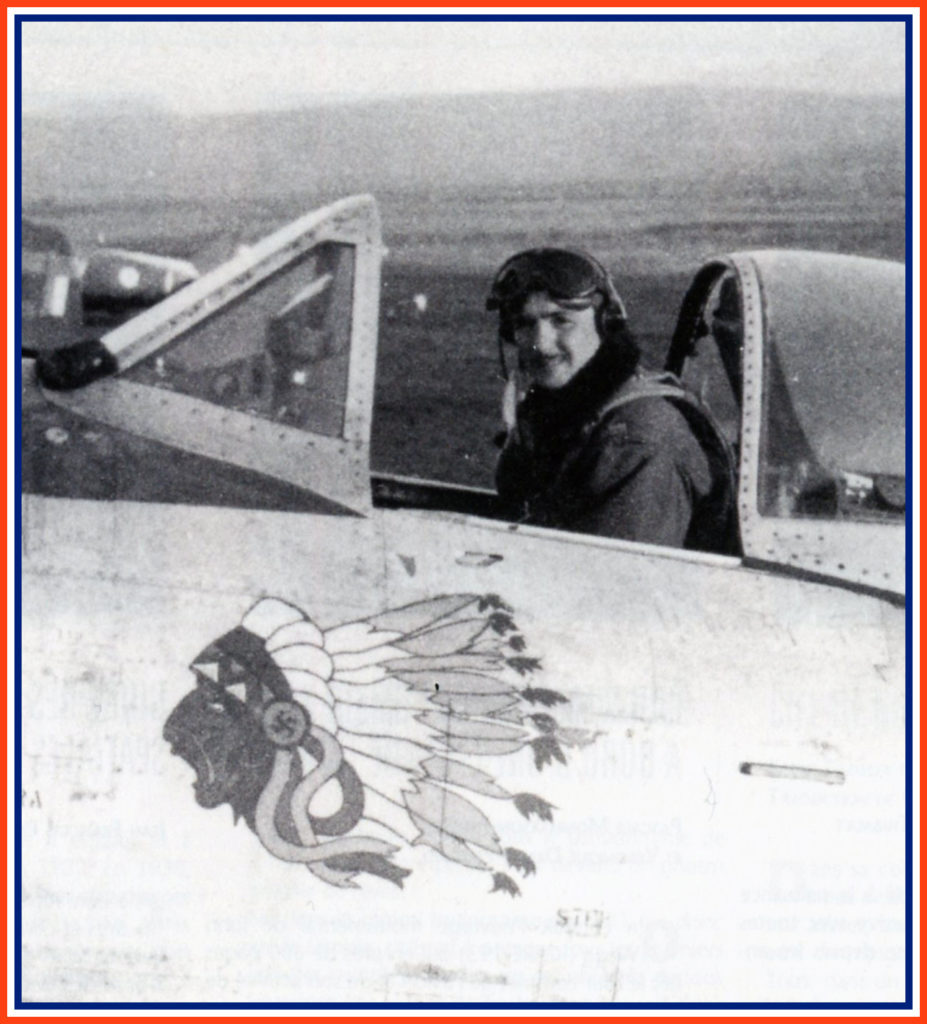
This type of uniform was still worn during the autumn of 1944 before being replaced in the following months by a flight suit better suited to the terrible weather conditions of the Alsatian winter of 1944 – 1945.


